Multiplication Facts Worksheets
Welcome to the multiplication facts worksheets page at Math-Drills.com! On this page, you will find Multiplication worksheets for practicing multiplication facts at various levels and in a variety of formats. This is our most popular page due to the wide variety of worksheets for multiplication available. Or it could be that learning multiplication facts and multiplication strategies are essential to many topics in mathematics beyond third grade math.
Learning multiplication facts to the point of quick recall should be a goal for all students and will serve them well in their math studies. Multiplication facts are actually easier to learn than you might think. First of all, it is only essential to learn the facts from 1 to 9. Somewhere along the way students can learn that anything multiplied by zero is zero. Hopefully, that is an easy one. Students also need to learn to multiply by ten as a precursor to learning how to multiply other powers of ten. After those three skills are learned, everything else is long multiplication. Multiplying by 11 is actually two-digit multiplication. Now, learning fact tables of 11 and beyond will do no harm to those students who are keen and able to learn these things quickly, and it might help them figure out how many eggs are in a gross faster than anyone else, but keep it simple for those students who struggle a bit more.

Most Popular Multiplication Facts Worksheets this Week
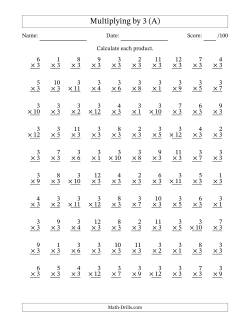
Multiplication Facts Tables
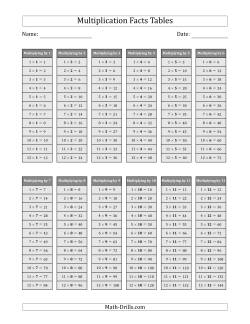
The multiplication tables with individual questions include a separate box for each number. In each box, the single number is multiplied by every other number with each question on one line. The tables may be used for various purposes such as introducing the multiplication tables, skip counting, as a lookup table, patterning activities, and memorizing.
- Multiplication Facts Tables from 1 to 12 Multiplication Facts Tables in Gray 1 to 12 Multiplication Facts Tables in Gray 1 to 12 (Answers Omitted) Multiplication Facts Tables in Color 1 to 12 Multiplication Facts Tables in Color 1 to 12 (Answers Omitted) Multiplication Facts Tables in Montessori Colors 1 to 12 Multiplication Facts Tables in Montessori Colors 1 to 12 (Answers Omitted)
- Multiplication Facts Tables from 0 to 11 Multiplication Facts Tables in Gray 0 to 11 Multiplication Facts Tables in Gray 0 to 11 (Answers Omitted) Multiplication Facts Tables in Color 0 to 11 Multiplication Facts Tables in Color 0 to 11 (Answers Omitted) Multiplication Facts Tables in Montessori Colors 0 to 11 Multiplication Facts Tables in Montessori Colors 0 to 11 (Answers Omitted)
- Multiplication Facts Tables from 13 to 24 Multiplication Facts Tables in Gray 13 to 24 Multiplication Facts Tables in Gray 13 to 24 (Answers Omitted) Multiplication Facts Tables in Color 13 to 24 Multiplication Facts Tables in Color 13 to 24 (Answers Omitted)
The compact multiplication tables are basically lookup charts. To look up a multiplication fact, find the first factor in the column header and the second factor in the row headers; then use straight edges, your fingers or your eyes to find where the column and row intersect to get the product. These tables are better than the previous tables for finding patterns, but they can be used in similar ways. Each PDF includes a filled out table page and a blank table page. The blank tables can be used for practice or assessment. You might also make a game out of it, such as "Pin the Fact on the Table" (a play on Pin the Tail on the Donkey). Students are given a product (answer) and they pin it on an enlarged version or the table (photocopier enlargement, interactive whiteboard, overhead projector, etc.). Paper-saving versions with multiple tables per page are included. The left-handed versions of the multiplication tables recognize that students who use their left hands might block the row headings on the right-handed versions.
- Compact Multiplication Facts Tables from 1 to 7 Multiplication Table to 49 (1 Filled and 1 Blank) Multiplication Table to 49 (9 Filled and 9 Blank) Left-Handed Multiplication Table to 49 (1 Filled and 1 Blank) Left-Handed Multiplication Table to 49 (9 Filled and 9 Blank)
- Compact Multiplication Facts Tables from 1 to 9 Multiplication Table to 81 (1 Filled and 1 Blank) Multiplication Table to 81 (6 Filled and 6 Blank) Left-Handed Multiplication Table to 81 (1 Filled and 1 Blank) Left-Handed Multiplication Table to 81 (6 Filled and 6 Blank)
- Compact Multiplication Facts Tables from 1 to 10 Multiplication Table to 100 (1 Filled and 1 Blank) Multiplication Table to 100 (6 Filled and 6 Blank) Left-Handed Multiplication Table to 100 (1 Filled and 1 Blank) Left-Handed Multiplication Table to 100 (6 Filled and 6 Blank)
- Compact Multiplication Facts Tables from 1 to 12 Multiplication Table to 144 (1 Filled and 1 Blank) Multiplication Table to 144 (4 Filled and 4 Blank) Left-Handed Multiplication Table to 144 (1 Filled and 1 Blank) Left-Handed Multiplication Table to 144 (4 Filled and 4 Blank)
Five Minute Multiplication Frenzies
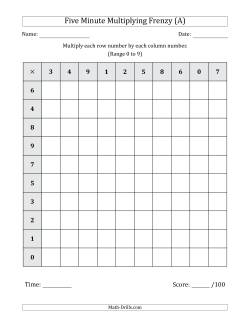
Five minute frenzy charts are 10 by 10 grids that are used for multiplication fact practice (up to 12 x 12) and improving recall speed. They are very much like compact multiplication tables, but all the numbers are mixed up, so students are unable to use skip counting to fill them out. In each square, students write the product of the column number and the row number. They try to complete the chart in a set time with an accuracy goal (such as less than five minutes and score 98 percent or better).
It is important to note here that you should NOT have students complete five minute frenzies if they don't already know all of the multiplication facts that appear on them. If you want them to participate with the rest of the class, cross off the rows and columns that they don't know and have them complete a modified version. Remember, these charts are for practice and improving recall, not a teaching tool by itself.
Students who write with their left hands may cover the row headings on the right-handed versions, so the left-handed versions have the row headings on the other side.
- Multiplication Frenzies from 0 to 9 Multiplication Frenzy with Factors from 0 to 9 ( 1 Chart Per Page) Multiplication Frenzy with Factors from 0 to 9 ( 4 Charts Per Page) Left-Handed Multiplication Frenzy with Factors from 0 to 9 ( 1 Chart Per Page) Left-Handed Multiplication Frenzy with Factors from 0 to 9 ( 4 Charts Per Page)
- Multiplication Frenzies from 1 to 10 Multiplication Frenzy with Factors from 1 to 10 ( 1 Chart Per Page) Multiplication Frenzy with Factors from 1 to 10 ( 4 Charts Per Page) Left-Handed Multiplication Frenzy with Factors from 1 to 10 ( 1 Chart Per Page) Left-Handed Multiplication Frenzy with Factors from 1 to 10 ( 4 Charts Per Page)
- Multiplication Frenzies from 2 to 12 Multiplication Frenzy with Factors from 2 to 12 ( 1 Chart Per Page) Multiplication Frenzy with Factors from 2 to 12 ( 4 Charts Per Page) Left-Handed Multiplication Frenzy with Factors from 2 to 12 ( 1 Chart Per Page) Left-Handed Multiplication Frenzy with Factors from 2 to 12 ( 4 Charts Per Page)
- Multiplication Frenzies from 5 to 15 Multiplication Frenzy with Factors from 5 to 15 ( 1 Chart Per Page) Multiplication Frenzy with Factors from 5 to 15 ( 4 Charts Per Page) Left-Handed Multiplication Frenzy with Factors from 5 to 15 ( 1 Chart Per Page) Left-Handed Multiplication Frenzy with Factors from 5 to 15 ( 4 Charts Per Page)
Multiplication Facts up to the 7 Times Table
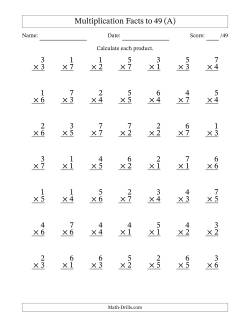
This section includes math worksheets for practicing multiplication facts to from 0 to 49. There are two worksheets in this section that include all of the possible questions exactly once on each page: the 49 question worksheet with no zeros and the 64 question worksheet with zeros. All others either contain all the possible questions plus some repeats or a unique subset of the possible questions.
- Multiplication Facts up to the 7 Times Table (No Zeros) Multiplication Facts to 49 ( 100 Questions) ( No Zeros ) ✎ Multiplication Facts to 49 ( 50 Questions ) ( No Zeros ) ✎ Multiplication Facts to 49 ( 49 Questions) ( No Zeros ) ✎ Multiplication Facts to 49 ( 25 Questions ) ( No Zeros ) ✎
- Multiplication Facts up to the 7 Times Table (With Zeros) Multiplication Facts to 49 ( 100 Questions) ( With Zeros ) ✎ Multiplication Facts to 49 ( 64 Questions) ( With Zeros ) ✎ Multiplication Facts to 49 ( 50 Questions ) ( With Zeros ) ✎ Multiplication Facts to 49 ( 25 Questions ) ( With Zeros ) ✎
- Horizontally Arranged Multiplication Facts up to the 5 Times Table Horizontally Arranged Multiplication Facts with Products to 25 ( 100 Questions) ✎ Horizontally Arranged Multiplication Facts with Products to 25 ( 50 Questions ) ✎ Horizontally Arranged Multiplication Facts with Products to 25 ( 25 Questions ; Large Print) ✎
- Horizontally Arranged Multiplication Facts up to the 6 Times Table Horizontally Arranged Multiplication Facts with Products to 36 ( 100 Questions) ✎ Horizontally Arranged Multiplication Facts with Products to 36 ( 50 Questions ) ✎ Horizontally Arranged Multiplication Facts with Products to 36 ( 25 Questions ; Large Print) ✎
- Horizontally Arranged Multiplication Facts up to the 7 Times Table Horizontally Arranged Multiplication Facts with Products to 49 ( 100 Questions) ✎ Horizontally Arranged Multiplication Facts with Products to 49 ( 50 Questions ) ✎ Horizontally Arranged Multiplication Facts with Products to 49 ( 25 Questions ; Large Print) ✎
When a student first learns multiplication facts, try not to overwhelm them with the entire multiplication table. The following worksheets include one row of the facts in order with the target digit on the bottom and one row with the target digit on the top. The remaining rows include each of the facts once, but the target digit is randomly placed on the top or the bottom and the facts are randomly mixed on each row.
- Multiplying (1 to 7) by Individual Facts Multiplying (1 to 7) by 1 ✎ Multiplying (1 to 7) by 2 ✎ Multiplying (1 to 7) by 3 ✎ Multiplying (1 to 7) by 4 ✎ Multiplying (1 to 7) by 5 ✎ Multiplying (1 to 7) by 6 ✎ Multiplying (1 to 7) by 7 ✎
- Multiplying (0 to 7) by Individual Facts Multiplying (0 to 7) by 0 ✎ Multiplying (0 to 7) by 1 ✎ Multiplying (0 to 7) by 2 ✎ Multiplying (0 to 7) by 3 ✎ Multiplying (0 to 7) by 4 ✎ Multiplying (0 to 7) by 5 ✎ Multiplying (0 to 7) by 6 ✎ Multiplying (0 to 7) by 7 ✎
- Horizontally Arranged Multiplying (1 to 7) by Individual Facts (100 Questions per page) Horizontally Arranged Multiplying (1 to 7) by 1 ( 100 Questions ) ✎ Horizontally Arranged Multiplying (1 to 7) by 2 ( 100 Questions ) ✎ Horizontally Arranged Multiplying (1 to 7) by 3 ( 100 Questions ) ✎ Horizontally Arranged Multiplying (1 to 7) by 4 ( 100 Questions ) ✎ Horizontally Arranged Multiplying (1 to 7) by 5 ( 100 Questions ) ✎ Horizontally Arranged Multiplying (1 to 7) by 6 ( 100 Questions ) ✎ Horizontally Arranged Multiplying (1 to 7) by 7 ( 100 Questions ) ✎
- Horizontally Arranged Multiplying (1 to 7) by Individual Facts (50 Questions per page) Horizontally Arranged Multiplying (1 to 7) by 1 ( 50 Questions ) ✎ Horizontally Arranged Multiplying (1 to 7) by 2 ( 50 Questions ) ✎ Horizontally Arranged Multiplying (1 to 7) by 3 ( 50 Questions ) ✎ Horizontally Arranged Multiplying (1 to 7) by 4 ( 50 Questions ) ✎ Horizontally Arranged Multiplying (1 to 7) by 5 ( 50 Questions ) ✎ Horizontally Arranged Multiplying (1 to 7) by 6 ( 50 Questions ) ✎ Horizontally Arranged Multiplying (1 to 7) by 7 ( 50 Questions ) ✎
- Horizontally Arranged Multiplying (1 to 7) by Individual Facts (25 Questions per page) Horizontally Arranged Multiplying (1 to 7) by 1 ( 25 Questions ; Large Print) ✎ Horizontally Arranged Multiplying (1 to 7) by 2 ( 25 Questions ; Large Print) ✎ Horizontally Arranged Multiplying (1 to 7) by 3 ( 25 Questions ; Large Print) ✎ Horizontally Arranged Multiplying (1 to 7) by 4 ( 25 Questions ; Large Print) ✎ Horizontally Arranged Multiplying (1 to 7) by 5 ( 25 Questions ; Large Print) ✎ Horizontally Arranged Multiplying (1 to 7) by 6 ( 25 Questions ; Large Print) ✎ Horizontally Arranged Multiplying (1 to 7) by 7 ( 25 Questions ; Large Print) ✎
- Multiplying Doubles Multiplying Doubles up to 7 x 7
Multiplication Facts up to the 9 Times Table
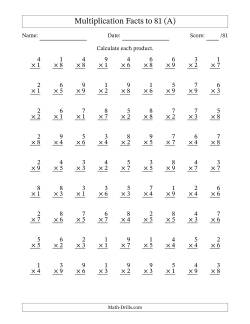
This section includes math worksheets for practicing multiplication facts from 0 to 81. There are three worksheets (marked with *) in this section that include all of the possible questions in the specified range exactly once on each page: the 64 question worksheet with no zeros or ones, the 81 question worksheet with no zeros, and the 100 question worksheet with zeros. All others either contain all the possible questions plus some repeats or a unique subset of the possible questions.
- Multiplication Facts up to the 9 Times Table (No Zeros or Ones) Multiplication Facts to 81 ( 100 Questions) ( No Zeros or Ones ) ✎ Multiplication Facts to 81 ( 81 Questions) ( No Zeros or Ones ) ✎ *Multiplication Facts to 81 ( 64 Questions) ( No Zeros or Ones ) ✎ Multiplication Facts to 81 ( 50 Questions ) ( No Zeros or Ones ) ✎ Multiplication Facts to 81 ( 25 Questions ) ( No Zeros or Ones ) ✎
- Multiplication Facts up to the 9 Times Table (No Zeros) Multiplication Facts to 81 ( 100 Questions) ( No Zeros ) ✎ *Multiplication Facts to 81 ( 81 Questions) ( No Zeros ) ✎ Multiplication Facts to 81 ( 50 Questions ) ( No Zeros ) ✎ Multiplication Facts to 81 ( 25 Questions ) ( No Zeros ) ✎
- Multiplication Facts up to the 9 Times Table (With Zeros) *Multiplication Facts to 81 ( 100 Questions) ( With Zeros ) ✎ Multiplication Facts to 81 ( 81 Questions) ( With Zeros ) ✎ Multiplication Facts to 81 ( 50 Questions ) ( With Zeros ) ✎ Multiplication Facts to 81 ( 25 Questions ) ( With Zeros ) ✎
- Horizontally Arranged Multiplication Facts up to the 8 Times Table Horizontally Arranged Multiplication Facts with Products to 64 ( 100 Questions) ✎ Horizontally Arranged Multiplication Facts with Products to 64 ( 50 Questions ) ✎ Horizontally Arranged Multiplication Facts with Products to 64 ( 25 Questions ; Large Print) ✎
- Horizontally Arranged Multiplication Facts up to the 9 Times Table Horizontally Arranged Multiplication Facts with Products to 81 ( 100 Questions) ✎ Horizontally Arranged Multiplication Facts with Products to 81 ( 50 Questions ) ✎ Horizontally Arranged Multiplication Facts with Products to 81 ( 25 Questions ; Large Print) ✎
When learning multiplication facts, it is useful to have each fact isolated on a set of practice questions to help reinforce the individual fact. The following worksheets isolate each fact. These worksheets can be used as practice sheets, assessment sheets, or in conjunction with another teaching strategy such as manipulative use.
- Multiplying (1 to 9) by Individual Facts (81 Questions per Page) Multiplying (1 to 9) by 0 ( 81 Questions) ✎ Multiplying (1 to 9) by 1 ( 81 Questions) ✎ Multiplying (1 to 9) by 2 ( 81 Questions) ✎ Multiplying (1 to 9) by 3 ( 81 Questions) ✎ Multiplying (1 to 9) by 4 ( 81 Questions) ✎ Multiplying (1 to 9) by 5 ( 81 Questions) ✎ Multiplying (1 to 9) by 6 ( 81 Questions) ✎ Multiplying (1 to 9) by 7 ( 81 Questions) ✎ Multiplying (1 to 9) by 8 ( 81 Questions) ✎ Multiplying (1 to 9) by 9 ( 81 Questions) ✎ Multiplying (1 to 9) by (3 and 4) ( 81 Questions) ✎ Multiplying (1 to 9) by (4 and 5) ( 81 Questions) ✎ Multiplying (1 to 9) by (5 and 6) ( 81 Questions) ✎ Multiplying (1 to 9) by (6 and 7) ( 81 Questions) ✎ Multiplying (1 to 9) by (7 and 8) ( 81 Questions) ✎ Multiplying (1 to 9) by (8 and 9) ( 81 Questions) ✎ Multiplying (1 to 9) by (6 to 8) ( 81 Questions) ✎ Multiplying (1 to 9) by (7 to 9) ( 81 Questions) ✎ Multiplying (1 to 9) by (6 to 9) ( 81 Questions) ✎
- Multiplying (2 to 9) by Individual Facts (100 Questions per Page) Multiplying (2 to 9) by (6 to 8) ( 100 Questions) ✎ Multiplying (2 to 9) by (7 to 9) ( 100 Questions) ✎
- Multiplying (1 to 9) by Individual Facts (36 Questions per Page; Large Print) Multiplying (1 to 9) by 0 ( 36 Questions) ✎ Multiplying (1 to 9) by 1 ( 36 Questions) ✎ Multiplying (1 to 9) by 2 ( 36 Questions) ✎ Multiplying (1 to 9) by 3 ( 36 Questions) ✎ Multiplying (1 to 9) by 4 ( 36 Questions) ✎ Multiplying (1 to 9) by 5 ( 36 Questions) ✎ Multiplying (1 to 9) by 6 ( 36 Questions) ✎ Multiplying (1 to 9) by 7 ( 36 Questions) ✎ Multiplying (1 to 9) by 8 ( 36 Questions) ✎ Multiplying (1 to 9) by 9 ( 36 Questions) ✎ Multiplying (1 to 9) by (6 and 7) ( 36 Questions) ✎ Multiplying (1 to 9) by (7 and 8) ( 36 Questions) ✎ Multiplying (1 to 9) by (8 and 9) ( 36 Questions) ✎ Multiplying (1 to 9) by (6 to 8) ( 36 Questions) ✎ Multiplying (1 to 9) by (7 to 9) ( 36 Questions) ✎ Multiplying (1 to 9) by (6 to 9) ( 36 Questions) ✎
- Horizontally Arranged Multiplying (0 to 9) by Individual Facts (100 Questions per Page) Horizontally Arranged Multiplying ( 0 to 9 ) by 0 ( 100 Questions) ✎ Horizontally Arranged Multiplying ( 0 to 9 ) by 1 ( 100 Questions) ✎ Horizontally Arranged Multiplying ( 0 to 9 ) by 2 ( 100 Questions) ✎ Horizontally Arranged Multiplying ( 0 to 9 ) by 3 ( 100 Questions) ✎ Horizontally Arranged Multiplying ( 0 to 9 ) by 4 ( 100 Questions) ✎ Horizontally Arranged Multiplying ( 0 to 9 ) by 5 ( 100 Questions) ✎ Horizontally Arranged Multiplying ( 0 to 9 ) by 6 ( 100 Questions) ✎ Horizontally Arranged Multiplying ( 0 to 9 ) by 7 ( 100 Questions) ✎ Horizontally Arranged Multiplying ( 0 to 9 ) by 8 ( 100 Questions) ✎ Horizontally Arranged Multiplying ( 0 to 9 ) by 9 ( 100 Questions) ✎
- Horizontally Arranged Multiplying (0 to 9) by Individual Facts (50 Questions per Page) Horizontally Arranged Multiplying ( 0 to 9 ) by 0 ( 50 Questions ) ✎ Horizontally Arranged Multiplying ( 0 to 9 ) by 1 ( 50 Questions ) ✎ Horizontally Arranged Multiplying ( 0 to 9 ) by 2 ( 50 Questions ) ✎ Horizontally Arranged Multiplying ( 0 to 9 ) by 3 ( 50 Questions ) ✎ Horizontally Arranged Multiplying ( 0 to 9 ) by 4 ( 50 Questions ) ✎ Horizontally Arranged Multiplying ( 0 to 9 ) by 5 ( 50 Questions ) ✎ Horizontally Arranged Multiplying ( 0 to 9 ) by 6 ( 50 Questions ) ✎ Horizontally Arranged Multiplying ( 0 to 9 ) by 7 ( 50 Questions ) ✎ Horizontally Arranged Multiplying ( 0 to 9 ) by 8 ( 50 Questions ) ✎ Horizontally Arranged Multiplying ( 0 to 9 ) by 9 ( 50 Questions ) ✎
- Horizontally Arranged Multiplying (0 to 9) by Individual Facts (25 Questions per Page; Large Print) Horizontally Arranged Multiplying ( 0 to 9 ) by 0 ( 25 Questions ; Large Print) ✎ Horizontally Arranged Multiplying ( 0 to 9 ) by 1 ( 25 Questions ; Large Print) ✎ Horizontally Arranged Multiplying ( 0 to 9 ) by 2 ( 25 Questions ; Large Print) ✎ Horizontally Arranged Multiplying ( 0 to 9 ) by 3 ( 25 Questions ; Large Print) ✎ Horizontally Arranged Multiplying ( 0 to 9 ) by 4 ( 25 Questions ; Large Print) ✎ Horizontally Arranged Multiplying ( 0 to 9 ) by 5 ( 25 Questions ; Large Print) ✎ Horizontally Arranged Multiplying ( 0 to 9 ) by 6 ( 25 Questions ; Large Print) ✎ Horizontally Arranged Multiplying ( 0 to 9 ) by 7 ( 25 Questions ; Large Print) ✎ Horizontally Arranged Multiplying ( 0 to 9 ) by 8 ( 25 Questions ; Large Print) ✎ Horizontally Arranged Multiplying ( 0 to 9 ) by 9 ( 25 Questions ; Large Print) ✎
- Multiplying Doubles Multiplying Doubles up to 9 x 9
Some students are a little more motivated when learning is turned into a game. Multiplication bingo encourages students to recall multiplication facts in an environment of competition.
- Multiplication Bingo Game Multiplication Bingo Cards for Facts 1 to 9 Multiplication Bingo Facts 1 to 9 Teacher Call Cards
Multiplication Facts up to the 10 Times Table
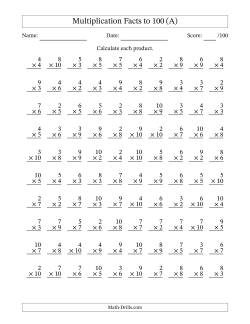
Multiplying by 10 is often a lesson itself, but here we have included it with the other facts. Students usually learn how to multiply by 10 fairly quickly, so this section really is not a whole lot more difficult than the multiplication facts to 81 section.
- Multiplication Facts up to the 10 Times Table (No Zeros or Ones) Multiplication Facts to 100 ( 100 Questions) ( No Zeros or Ones ) ✎ *Multiplication Facts to 100 ( 81 Questions) ( No Zeros or Ones ) ✎ Multiplication Facts to 100 ( 50 Questions ) ( No Zeros or Ones ) ✎ Multiplication Facts to 100 ( 25 Questions ) ( No Zeros or Ones ) ✎
- Multiplication Facts up to the 10 Times Table (No Zeros) *Multiplication Facts to 100 ( 100 Questions) ( No Zeros ) ✎ Multiplication Facts to 100 ( 50 Questions ) ( No Zeros ) ✎ Multiplication Facts to 100 ( 25 Questions ) ( No Zeros ) ✎
- Multiplication Facts up to the 10 Times Table (With Zeros) Multiplication Facts to 100 ( 100 Questions) ( With Zeros ) ✎ Multiplication Facts to 100 ( 50 Questions ) ( With Zeros ) ✎ Multiplication Facts to 100 ( 25 Questions ) ( With Zeros ) ✎
- Horizontally Arranged Multiplication Facts up to the 10 Times Table Horizontally Arranged Multiplication Facts to 10 × 10 = 100 ( 100 Questions) ✎ Horizontally Arranged Multiplication Facts to 10 × 10 = 100 ( 50 Questions ) ✎
Some students find it easier to focus on one multiplication fact at a time. These multiplication worksheets include some repetition, of course, as there is only one thing to multiply by. Once students practice a few times, these facts will probably get stuck in their heads for life. Some of the later versions include a range of focus numbers. In those cases, each question will randomly have one of the focus numbers in question. For example, if the range is 6 to 8, the question might include a 6, 7 or 8 or more than one depending on which other factor was chosen for the second factor.
- Multiplying (1 to 10) by Individual Facts (100 Questions per Page) Multiplying (1 to 10) by 0 ( 100 Questions) ✎ Multiplying (1 to 10) by 1 ( 100 Questions) ✎ Multiplying (1 to 10) by 2 ( 100 Questions) ✎ Multiplying (1 to 10) by 3 ( 100 Questions) ✎ Multiplying (1 to 10) by 4 ( 100 Questions) ✎ Multiplying (1 to 10) by 5 ( 100 Questions) ✎ Multiplying (1 to 10) by 6 ( 100 Questions) ✎ Multiplying (1 to 10) by 7 ( 100 Questions) ✎ Multiplying (1 to 10) by 8 ( 100 Questions) ✎ Multiplying (1 to 10) by 9 ( 100 Questions) ✎ Multiplying (1 to 10) by 10 ( 100 Questions) ✎
- Multiplying (1 to 10) by Ranges Individual Facts (100 Questions per Page) Multiplying (1 to 10) by (6 and 7) ( 100 Questions) ✎ Multiplying (1 to 10) by (7 and 8) ( 100 Questions) ✎ Multiplying (1 to 10) by (8 and 9) ( 100 Questions) ✎ Multiplying (1 to 10) by (9 and 10) ( 100 Questions) ✎ Multiplying (1 to 10) by (6 to 8) ( 100 Questions) ✎ Multiplying (1 to 10) by (7 to 9) ( 100 Questions) ✎ Multiplying (1 to 10) by (8 to 10) ( 100 Questions) ✎ Multiplying Doubles (aka Squares) from (1 to 10) ( 100 Questions)
- Multiplying (1 to 10) by Individual Facts (50 Questions per Page) Multiplying (1 to 10) by 0 ( 50 Questions ) ✎ Multiplying (1 to 10) by 1 ( 50 Questions ) ✎ Multiplying (1 to 10) by 2 ( 50 Questions ) ✎ Multiplying (1 to 10) by 3 ( 50 Questions ) ✎ Multiplying (1 to 10) by 4 ( 50 Questions ) ✎ Multiplying (1 to 10) by 5 ( 50 Questions ) ✎ Multiplying (1 to 10) by 6 ( 50 Questions ) ✎ Multiplying (1 to 10) by 7 ( 50 Questions ) ✎ Multiplying (1 to 10) by 8 ( 50 Questions ) ✎ Multiplying (1 to 10) by 9 ( 50 Questions ) ✎ Multiplying (1 to 10) by 10 ( 50 Questions ) ✎
- Multiplying (1 to 10) by Ranges of Individual Facts (50 Questions per Page) Multiplying (1 to 10) by (6 and 7) ( 50 Questions ) ✎ Multiplying (1 to 10) by (7 and 8) ( 50 Questions ) ✎ Multiplying (1 to 10) by (8 and 9) ( 50 Questions ) ✎ Multiplying (1 to 10) by (9 and 10) ( 50 Questions ) ✎ Multiplying (1 to 10) by (6 to 8) ( 50 Questions ) ✎ Multiplying (1 to 10) by (7 to 9) ( 50 Questions ) ✎ Multiplying (1 to 10) by (8 to 10) ( 50 Questions ) ✎
- Multiplying (1 to 10) by Individual Facts (36 Questions per Page) Multiplying (1 to 10) by 0 ( 36 Questions) ✎ Multiplying (1 to 10) by 1 ( 36 Questions) ✎ Multiplying (1 to 10) by 2 ( 36 Questions) ✎ Multiplying (1 to 10) by 3 ( 36 Questions) ✎ Multiplying (1 to 10) by 4 ( 36 Questions) ✎ Multiplying (1 to 10) by 5 ( 36 Questions) ✎ Multiplying (1 to 10) by 6 ( 36 Questions) ✎ Multiplying (1 to 10) by 7 ( 36 Questions) ✎ Multiplying (1 to 10) by 8 ( 36 Questions) ✎ Multiplying (1 to 10) by 9 ( 36 Questions) ✎ Multiplying (1 to 10) by 10 ( 36 Questions) ✎
- Multiplying (1 to 10) by Ranges of Individual Facts (42 Questions per Page) Multiplying (1 to 10) by (6 and 7) ( 42 Questions) ✎ Multiplying (1 to 10) by (7 and 8) ( 42 Questions) ✎ Multiplying (1 to 10) by (8 and 9) ( 42 Questions) ✎ Multiplying (1 to 10) by (9 and 10) ( 42 Questions) ✎ Multiplying (1 to 10) by (6 to 8) ( 42 Questions) ✎ Multiplying (1 to 10) by (7 to 9) ( 42 Questions) ✎ Multiplying (1 to 10) by (8 to 10) ( 42 Questions) ✎
- Horizontally Arranged Multiplying (1 to 10) by Individual Facts (100 Questions per Page) Horizontally Arranged Multiplying (1 to 10) by 1 ( 100 Questions ) ✎ Horizontally Arranged Multiplying (1 to 10) by 2 ( 100 Questions ) ✎ Horizontally Arranged Multiplying (1 to 10) by 3 ( 100 Questions ) ✎ Horizontally Arranged Multiplying (1 to 10) by 4 ( 100 Questions ) ✎ Horizontally Arranged Multiplying (1 to 10) by 5 ( 100 Questions ) ✎ Horizontally Arranged Multiplying (1 to 10) by 6 ( 100 Questions ) ✎ Horizontally Arranged Multiplying (1 to 10) by 7 ( 100 Questions ) ✎ Horizontally Arranged Multiplying (1 to 10) by 8 ( 100 Questions ) ✎ Horizontally Arranged Multiplying (1 to 10) by 9 ( 100 Questions ) ✎ Horizontally Arranged Multiplying (1 to 10) by 10 ( 100 Questions ) ✎
- Horizontally Arranged Multiplying (1 to 10) by Individual Facts (50 Questions per Page) Horizontally Arranged Multiplying (1 to 10) by 1 ( 50 Questions ) ✎ Horizontally Arranged Multiplying (1 to 10) by 2 ( 50 Questions ) ✎ Horizontally Arranged Multiplying (1 to 10) by 3 ( 50 Questions ) ✎ Horizontally Arranged Multiplying (1 to 10) by 4 ( 50 Questions ) ✎ Horizontally Arranged Multiplying (1 to 10) by 5 ( 50 Questions ) ✎ Horizontally Arranged Multiplying (1 to 10) by 6 ( 50 Questions ) ✎ Horizontally Arranged Multiplying (1 to 10) by 7 ( 50 Questions ) ✎ Horizontally Arranged Multiplying (1 to 10) by 8 ( 50 Questions ) ✎ Horizontally Arranged Multiplying (1 to 10) by 9 ( 50 Questions ) ✎ Horizontally Arranged Multiplying (1 to 10) by 10 ( 50 Questions ) ✎
- Horizontally Arranged Multiplying (1 to 10) by Individual Facts (25 Questions per Page; Large Print) Horizontally Arranged Multiplying (1 to 10) by 1 ( 25 Questions ; Large Print) ✎ Horizontally Arranged Multiplying (1 to 10) by 2 ( 25 Questions ; Large Print) ✎ Horizontally Arranged Multiplying (1 to 10) by 3 ( 25 Questions ; Large Print) ✎ Horizontally Arranged Multiplying (1 to 10) by 4 ( 25 Questions ; Large Print) ✎ Horizontally Arranged Multiplying (1 to 10) by 5 ( 25 Questions ; Large Print) ✎ Horizontally Arranged Multiplying (1 to 10) by 6 ( 25 Questions ; Large Print) ✎ Horizontally Arranged Multiplying (1 to 10) by 7 ( 25 Questions ; Large Print) ✎ Horizontally Arranged Multiplying (1 to 10) by 8 ( 25 Questions ; Large Print) ✎ Horizontally Arranged Multiplying (1 to 10) by 9 ( 25 Questions ; Large Print) ✎ Horizontally Arranged Multiplying (1 to 10) by 10 ( 25 Questions ; Large Print) ✎
If a student is learning their times tables one at a time, these worksheets will help with practice and assessment along the way. Each one increases the range for the second factor.
- Multiplying (1 to 10) by Increasing Ranges of Individual Facts (100 Questions per Page) Multiplying (1 to 10) by (1 and 2) ( 100 Questions) ✎ Multiplying (1 to 10) by (1 to 3) ( 100 Questions) ✎ Multiplying (1 to 10) by (1 to 4) ( 100 Questions) ✎ Multiplying (1 to 10) by (1 to 5) ( 100 Questions) ✎ Multiplying (1 to 10) by (1 to 6) ( 100 Questions) ✎ Multiplying (1 to 10) by (1 to 7) ( 100 Questions) ✎ Multiplying (1 to 10) by (1 to 8) ( 100 Questions) ✎ Multiplying (1 to 10) by (1 to 9) ( 100 Questions) ✎
- Multiplying (1 to 10) by Increasing Ranges of Individual Facts (50 Questions per Page) Multiplying (1 to 10) by (1 and 2) ( 50 Questions ) ✎ Multiplying (1 to 10) by (1 to 3) ( 50 Questions ) ✎ Multiplying (1 to 10) by (1 to 4) ( 50 Questions ) ✎ Multiplying (1 to 10) by (1 to 5) ( 50 Questions ) ✎ Multiplying (1 to 10) by (1 to 6) ( 50 Questions ) ✎ Multiplying (1 to 10) by (1 to 7) ( 50 Questions ) ✎ Multiplying (1 to 10) by (1 to 8) ( 50 Questions ) ✎ Multiplying (1 to 10) by (1 to 9) ( 50 Questions ) ✎
- Multiplying Doubles Multiplying Doubles up to 10 x 10
Multiplication Facts up to the 12 Times Table
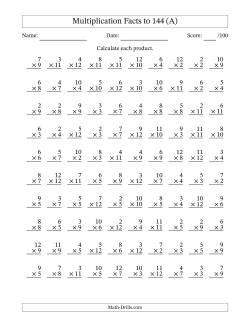
The Holy Grail of elementary mathematics. Once you learn your twelve times table, it is smooth sailing from now on, right? Well, not exactly, but having a good mental recall of the multiplication facts up to 144 will certainly set you on the right path for future success in your math studies.
- Multiplication Facts up to the 12 Times Table (No Zeros or Ones) Multiplication Facts to 144 ( 100 Questions) ( No Zeros or Ones ) ✎ Multiplication Facts to 144 ( 50 Questions ) ( No Zeros or Ones ) ✎ Multiplication Facts to 144 ( 25 Questions ) ( No Zeros or Ones ) ✎
- Multiplication Facts up to the 12 Times Table (No Zeros) Multiplication Facts to 144 ( 100 Questions) ( No Zeros ) ✎ Multiplication Facts to 144 ( 50 Questions ) ( No Zeros ) ✎ Multiplication Facts to 144 ( 25 Questions ) ( No Zeros ) ✎
- Multiplication Facts up to the 12 Times Table (With Zeros) Multiplication Facts to 144 ( 100 Questions) ( With Zeros ) ✎ Multiplication Facts to 144 ( 50 Questions ) ( With Zeros ) ✎ Multiplication Facts to 144 ( 25 Questions ) ( With Zeros ) ✎
- Horizontally Arranged Multiplication Facts up to the 11 Times Table Horizontally Arranged Multiplication Facts to 11 × 11 = 121 ( 100 Questions) ✎ Horizontally Arranged Multiplication Facts to 11 × 11 = 121 ( 50 Questions ) ✎
- Horizontally Arranged Multiplication Facts up to the 12 Times Table Horizontally Arranged Multiplication Facts to 12 × 12 = 144 ( 100 Questions) ✎ Horizontally Arranged Multiplication Facts to 12 × 12 = 144 ( 50 Questions ) ✎
With one, two or three target numbers at a time, students are able to practice just the multiplication facts they need.
- Multiplying (1 to 12) by Individual Facts (100 Questions per Page) Multiplying (1 to 12) By 0 ( 100 Questions) ✎ Multiplying (1 to 12) By 1 ( 100 Questions) ✎ Multiplying (1 to 12) By 2 ( 100 Questions) ✎ Multiplying (1 to 12) By 3 ( 100 Questions) ✎ Multiplying (1 to 12) By 4 ( 100 Questions) ✎ Multiplying (1 to 12) By 5 ( 100 Questions) ✎ Multiplying (1 to 12) By 6 ( 100 Questions) ✎ Multiplying (1 to 12) By 7 ( 100 Questions) ✎ Multiplying (1 to 12) By 8 ( 100 Questions) ✎ Multiplying (1 to 12) By 9 ( 100 Questions) ✎ Multiplying (1 to 12) By 10 ( 100 Questions) ✎ Multiplying (1 to 12) By 11 ( 100 Questions) ✎ Multiplying (1 to 12) By 12 ( 100 Questions) ✎
- Multiplying (1 to 12) by RAnges of Individual Facts (100 Questions per Page) Multiplying (1 to 12) By (0 and 1) ( 100 Questions) ✎ Multiplying (1 to 12) By (6 and 7) ( 100 Questions) Multiplying (1 to 12) By (7 and 8) ( 100 Questions) ✎ Multiplying (1 to 12) By (8 and 9) ( 100 Questions) ✎ Multiplying (1 to 12) By (9 and 10) ( 100 Questions) ✎ Multiplying (1 to 12) By (10 and 11) ( 100 Questions) ✎ Multiplying (1 to 12) By (11 and 12) ( 100 Questions) ✎ Multiplying (1 to 12) By (6, 7 and 8) ( 100 Questions) ✎ Multiplying (1 to 12) By (7, 8 and 9) ( 100 Questions) ✎ Multiplying (1 to 12) By (8, 9 and 10) ( 100 Questions) ✎ Multiplying (1 to 12) By (9, 10 and 11) ( 100 Questions) ✎ Multiplying (1 to 12) By (10, 11 and 12) ( 100 Questions) ✎
- Multiplying (1 to 12) by Individual Facts (50 Questions per Page) Multiplying (1 to 12) By 0 ( 50 Questions ) ✎ Multiplying (1 to 12) By 1 ( 50 Questions ) ✎ Multiplying (1 to 12) By 2 ( 50 Questions ) ✎ Multiplying (1 to 12) By 3 ( 50 Questions ) ✎ Multiplying (1 to 12) By 4 ( 50 Questions ) ✎ Multiplying (1 to 12) By 5 ( 50 Questions ) ✎ Multiplying (1 to 12) By 6 ( 50 Questions ) ✎ Multiplying (1 to 12) By 7 ( 50 Questions ) ✎ Multiplying (1 to 12) By 8 ( 50 Questions ) ✎ Multiplying (1 to 12) By 9 ( 50 Questions ) ✎ Multiplying (1 to 12) By 10 ( 50 Questions ) ✎ Multiplying (1 to 12) By 11 ( 50 Questions ) ✎ Multiplying (1 to 12) By 12 ( 50 Questions ) ✎
- Multiplying (1 to 12) by Ranges of Individual Facts (50 Questions per Page) Multiplying (1 to 12) By (6 and 7) ( 50 Questions ) ✎ Multiplying (1 to 12) By (7 and 8) ( 50 Questions ) ✎ Multiplying (1 to 12) By (8 and 9) ( 50 Questions ) ✎ Multiplying (1 to 12) By (9 and 10) ( 50 Questions ) ✎ Multiplying (1 to 12) By (10 and 11) ( 50 Questions ) ✎ Multiplying (1 to 12) By (11 and 12) ( 50 Questions ) ✎ Multiplying (1 to 12) By (6, 7 and 8) ( 50 Questions ) ✎ Multiplying (1 to 12) By (7, 8 and 9) ( 50 Questions ) ✎ Multiplying (1 to 12) By (8, 9 and 10) ( 50 Questions ) ✎ Multiplying (1 to 12) By (9, 10 and 11) ( 50 Questions ) ✎ Multiplying (1 to 12) By (10, 11 and 12) ( 50 Questions ) ✎
- Horizontally Arranged Multiplying (0 to 12) by Individual Facts (100 Questions per Page) Horizontally Arranged Multiplying ( 0 to 12 ) by 0 ( 100 Questions) ✎ Horizontally Arranged Multiplying ( 0 to 12 ) by 1 ( 100 Questions) ✎ Horizontally Arranged Multiplying ( 0 to 12 ) by 2 ( 100 Questions) ✎ Horizontally Arranged Multiplying ( 0 to 12 ) by 3 ( 100 Questions) ✎ Horizontally Arranged Multiplying ( 0 to 12 ) by 4 ( 100 Questions) ✎ Horizontally Arranged Multiplying ( 0 to 12 ) by 5 ( 100 Questions) ✎ Horizontally Arranged Multiplying ( 0 to 12 ) by 6 ( 100 Questions) ✎ Horizontally Arranged Multiplying ( 0 to 12 ) by 7 ( 100 Questions) ✎ Horizontally Arranged Multiplying ( 0 to 12 ) by 8 ( 100 Questions) ✎ Horizontally Arranged Multiplying ( 0 to 12 ) by 9 ( 100 Questions) ✎ Horizontally Arranged Multiplying ( 0 to 12 ) by 10 ( 100 Questions) ✎ Horizontally Arranged Multiplying ( 0 to 12 ) by 11 ( 100 Questions) ✎ Horizontally Arranged Multiplying ( 0 to 12 ) by 12 ( 100 Questions) ✎
- Horizontally Arranged Multiplying (0 to 12) by Individual Facts (50 Questions per Page) Horizontally Arranged Multiplying ( 0 to 12 ) by 0 ( 50 Questions ) ✎ Horizontally Arranged Multiplying ( 0 to 12 ) by 1 ( 50 Questions ) ✎ Horizontally Arranged Multiplying ( 0 to 12 ) by 2 ( 50 Questions ) ✎ Horizontally Arranged Multiplying ( 0 to 12 ) by 3 ( 50 Questions ) ✎ Horizontally Arranged Multiplying ( 0 to 12 ) by 4 ( 50 Questions ) ✎ Horizontally Arranged Multiplying ( 0 to 12 ) by 5 ( 50 Questions ) ✎ Horizontally Arranged Multiplying ( 0 to 12 ) by 6 ( 50 Questions ) ✎ Horizontally Arranged Multiplying ( 0 to 12 ) by 7 ( 50 Questions ) ✎ Horizontally Arranged Multiplying ( 0 to 12 ) by 8 ( 50 Questions ) ✎ Horizontally Arranged Multiplying ( 0 to 12 ) by 9 ( 50 Questions ) ✎ Horizontally Arranged Multiplying ( 0 to 12 ) by 10 ( 50 Questions ) ✎ Horizontally Arranged Multiplying ( 0 to 12 ) by 11 ( 50 Questions ) ✎ Horizontally Arranged Multiplying ( 0 to 12 ) by 12 ( 50 Questions ) ✎
- Horizontally Arranged Multiplying (0 to 12) by Individual Facts (25 Questions per Page; Large Print) Horizontally Arranged Multiplying ( 0 to 12 ) by 0 ( 25 Questions ; Large Print) ✎ Horizontally Arranged Multiplying ( 0 to 12 ) by 1 ( 25 Questions ; Large Print) ✎ Horizontally Arranged Multiplying ( 0 to 12 ) by 2 ( 25 Questions ; Large Print) ✎ Horizontally Arranged Multiplying ( 0 to 12 ) by 3 ( 25 Questions ; Large Print) ✎ Horizontally Arranged Multiplying ( 0 to 12 ) by 4 ( 25 Questions ; Large Print) ✎ Horizontally Arranged Multiplying ( 0 to 12 ) by 5 ( 25 Questions ; Large Print) ✎ Horizontally Arranged Multiplying ( 0 to 12 ) by 6 ( 25 Questions ; Large Print) ✎ Horizontally Arranged Multiplying ( 0 to 12 ) by 7 ( 25 Questions ; Large Print) ✎ Horizontally Arranged Multiplying ( 0 to 12 ) by 8 ( 25 Questions ; Large Print) ✎ Horizontally Arranged Multiplying ( 0 to 12 ) by 9 ( 25 Questions ; Large Print) ✎ Horizontally Arranged Multiplying ( 0 to 12 ) by 10 ( 25 Questions ; Large Print) ✎ Horizontally Arranged Multiplying ( 0 to 12 ) by 11 ( 25 Questions ; Large Print) ✎ Horizontally Arranged Multiplying ( 0 to 12 ) by 12 ( 25 Questions ; Large Print) ✎
In the following multiplication worksheets, the facts are grouped into anchor groups.
- Multiplying (1 to 12) by Anchor Facts (Commonly Grouped Facts) Multiplying by Anchor Facts 0, 1, 2, 5 and 10 Multiplying by Facts 3, 4 and 6 Multiplying by Facts 7, 8 and 9 Multiplying by Facts 11 and 12 Multiplying by Facts 0 to 5 and 10 Multiplying by Facts 0 to 7 and 10 Multiplying by Facts 0 to 10
- Multiplying (1 to 12) by Increasing Ranges of Individual Facts (100 Questions per Page) Multiplying (1 to 12) by (1 to 5) ( 100 Questions) ✎ Multiplying (1 to 12) by (1 to 6) ( 100 Questions) ✎ Multiplying (1 to 12) by (1 to 7) ( 100 Questions) ✎ Multiplying (1 to 12) by (1 to 8) ( 100 Questions) ✎ Multiplying (1 to 12) by (1 to 9) ( 100 Questions) ✎ Multiplying (1 to 12) by (1 to 10) ( 100 Questions) ✎ Multiplying (1 to 12) by (1 to 11) ( 100 Questions) ✎
- Multiplying (1 to 12) by Increasing Ranges of Individual Facts (50 Questions per Page) Multiplying (1 to 12) by (1 to 5) ( 50 Questions ) ✎ Multiplying (1 to 12) by (1 to 6) ( 50 Questions ) ✎ Multiplying (1 to 12) by (1 to 7) ( 50 Questions ) ✎ Multiplying (1 to 12) by (1 to 8) ( 50 Questions ) ✎ Multiplying (1 to 12) by (1 to 9) ( 50 Questions ) ✎ Multiplying (1 to 12) by (1 to 10) ( 50 Questions ) ✎ Multiplying (1 to 12) by (1 to 11) ( 50 Questions ) ✎
On the following multiplication worksheets, the questions are in order and might be useful for students to remember their times tables or to help them with skip counting.
- Repetitive Multiplying of Individual Facts by (1 to 12) Repetitive Multiplying of 1 by (1 to 12) Repetitive Multiplying of 2 by (1 to 12) Repetitive Multiplying of 3 by (1 to 12) Repetitive Multiplying of 4 by (1 to 12) Repetitive Multiplying of 5 by (1 to 12) Repetitive Multiplying of 6 by (1 to 12) Repetitive Multiplying of 7 by (1 to 12) Repetitive Multiplying of 8 by (1 to 12) Repetitive Multiplying of 9 by (1 to 12) Repetitive Multiplying of 10 by (1 to 12) Repetitive Multiplying of 11 by (1 to 12) Repetitive Multiplying of 12 by (1 to 12)
- Multiplying Doubles Multiplying Doubles up to 12 x 12
Multiplication Facts beyond the 12 Times Table
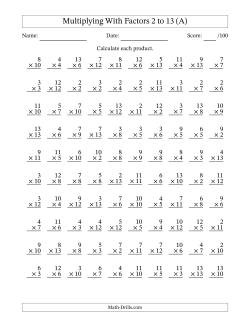
It is quite likely that there are students who have mastered all of the multiplication facts up to the 12 times tables. In case they want/need an extra challenge, this sections includes multiplication facts worksheets above 12 with the expectation that students will use mental math or recall to calculate the answers.
- Multiplying with Increasing Upper Range Factors from 13 to 20 Multiplying with Factors 2 to 13 (100 Questions) ✎ Multiplying with Factors 2 to 14 (100 Questions) ✎ Multiplying with Factors 2 to 15 (100 Questions) ✎ Multiplying with Factors 5 to 15 (100 Questions) ✎ Multiplying with Factors 5 to 16 (100 Questions) ✎ Multiplying with Factors 5 to 17 (100 Questions) ✎ Multiplying with Factors 5 to 18 (100 Questions) ✎ Multiplying with Factors 5 to 19 (100 Questions) ✎ Multiplying with Factors 5 to 20 (100 Questions) ✎
- Multiplying by Individual Facts from 13 to 25 Multiplying by 13 (49 Questions) ✎ Multiplying by 14 (49 Questions) ✎ Multiplying by 15 (49 Questions) ✎ Multiplying by 16 (49 Questions) ✎ Multiplying by 17 (49 Questions) ✎ Multiplying by 18 (49 Questions) ✎ Multiplying by 19 (49 Questions) ✎ Multiplying by 20 (49 Questions) ✎ Multiplying by 21 (49 Questions) ✎ Multiplying by 22 (49 Questions) ✎ Multiplying by 23 (49 Questions) ✎ Multiplying by 24 (49 Questions) ✎ Multiplying by 25 (49 Questions) ✎
Expand your mental math abilities by learning multiplication facts beyond the twelve times tables with these worksheets. They are horizontally arranged, so you won't be tempted to use an algorithm. Even if you can't recall all these facts yet, you can still figure them out using the distributive property. Let's say you want to multiply 19 by 19, that could be (10 × 19) + (9 × 19). Too hard? How about (10 × 10) + (10 × 9) + (9 × 10) + (9 × 9)! Or just remember that 19 × 19 = 361 :)
- Horizontally Arranged Multiplying with Increasing Upper Range Factors from 13 to 25 Horizontally Arranged Multiplying with Factors 1 to 13 (100 Questions) ✎ Horizontally Arranged Multiplying with Factors 1 to 14 (100 Questions) ✎ Horizontally Arranged Multiplying with Factors 1 to 15 (100 Questions) ✎ Horizontally Arranged Multiplying with Factors 2 to 16 (100 Questions) ✎ Horizontally Arranged Multiplying with Factors 2 to 17 (100 Questions) ✎ Horizontally Arranged Multiplying with Factors 2 to 18 (100 Questions) ✎ Horizontally Arranged Multiplying with Factors 2 to 19 (100 Questions) ✎ Horizontally Arranged Multiplying with Factors 2 to 20 (100 Questions) ✎ Horizontally Arranged Multiplying with Factors 5 to 21 (100 Questions) ✎ Horizontally Arranged Multiplying with Factors 5 to 22 (100 Questions) ✎ Horizontally Arranged Multiplying with Factors 5 to 23 (100 Questions) ✎ Horizontally Arranged Multiplying with Factors 5 to 24 (100 Questions) ✎ Horizontally Arranged Multiplying with Factors 5 to 25 (100 Questions) ✎
- Horizontally Arranged Multiplying by Individual Facts from 13 to 25 Horizontally Arranged Multiplying (1 to 13) by 13 (100 Questions) ✎ Horizontally Arranged Multiplying (1 to 14) by 14 (100 Questions) ✎ Horizontally Arranged Multiplying (1 to 15) by 15 (100 Questions) ✎ Horizontally Arranged Multiplying (1 to 16) by 16 (100 Questions) ✎ Horizontally Arranged Multiplying (1 to 17) by 17 (100 Questions) ✎ Horizontally Arranged Multiplying (1 to 18) by 18 (100 Questions) ✎ Horizontally Arranged Multiplying (1 to 19) by 19 (100 Questions) ✎ Horizontally Arranged Multiplying (1 to 20) by 20 (100 Questions) ✎ Horizontally Arranged Multiplying (1 to 21) by 21 (100 Questions) ✎ Horizontally Arranged Multiplying (1 to 22) by 22 (100 Questions) ✎ Horizontally Arranged Multiplying (1 to 23) by 23 (100 Questions) ✎ Horizontally Arranged Multiplying (1 to 24) by 24 (100 Questions) ✎ Horizontally Arranged Multiplying (1 to 25) by 25 (100 Questions) ✎
- Multiplying Doubles Multiplying Doubles up to 15 x 15 Multiplying Doubles up to 20 x 20
Copyright © 2005-2024 Math-Drills.com You may use the math worksheets on this website according to our Terms of Use to help students learn math.
Multiplication Worksheets
Mixed tables worksheets.
| Worksheet | Number Range | Online | ||
|---|---|---|---|---|
| 1 to 4 | ||||
| 2 to 6 | ||||
| 2 to 10 | ||||
| 2 to 12 | ||||
| 3 to 15 | ||||
| 6 to 20 | ||||
| 8 to 30 | ||||
| 12 to 100 |
Individual Table Worksheets
| Worksheet | Online | |
|---|---|---|
- Home |
- About |
- Contact Us |
- Privacy |
- Newsletter |
- Shop |
- 🔍 Search Site
- Easter Color By Number Sheets
- Printable Easter Dot to Dot
- Easter Worksheets for kids
- Kindergarten
- All Generated Sheets
- Place Value Generated Sheets
- Addition Generated Sheets
- Subtraction Generated Sheets
- Multiplication Generated Sheets
- Division Generated Sheets
- Money Generated Sheets
- Negative Numbers Generated Sheets
- Fraction Generated Sheets
- Place Value Zones
- Number Bonds
- Addition & Subtraction
- Times Tables
- Fraction & Percent Zones
- All Calculators
- Fraction Calculators
- Percent calculators
- Area & Volume Calculators
- Age Calculator
- Height Calculator
- Roman Numeral Calculator
- Coloring Pages
- Fun Math Sheets
- Math Puzzles
- Mental Math Sheets
- Online Times Tables
- Online Addition & Subtraction
- Math Grab Packs
- All Math Quizzes
- 1st Grade Quizzes
- 2nd Grade Quizzes
- 3rd Grade Quizzes
- 4th Grade Quizzes
- 5th Grade Quizzes
- 6th Grade Math Quizzes
- Place Value
- Rounding Numbers
- Comparing Numbers
- Number Lines
- Prime Numbers
- Negative Numbers
- Roman Numerals
- Subtraction
- Add & Subtract
- Multiplication
- Fraction Worksheets
- Learning Fractions
- Fraction Printables
- Percent Worksheets & Help
- All Geometry
- 2d Shapes Worksheets
- 3d Shapes Worksheets
- Shape Properties
- Geometry Cheat Sheets
- Printable Shapes
- Coordinates
- Measurement
- Math Conversion
- Statistics Worksheets
- Bar Graph Worksheets
- Venn Diagrams
- All Word Problems
- Finding all possibilities
- Logic Problems
- Ratio Word Problems
- All UK Maths Sheets
- Year 1 Maths Worksheets
- Year 2 Maths Worksheets
- Year 3 Maths Worksheets
- Year 4 Maths Worksheets
- Year 5 Maths Worksheets
- Year 6 Maths Worksheets
- All AU Maths Sheets
- Kindergarten Maths Australia
- Year 1 Maths Australia
- Year 2 Maths Australia
- Year 3 Maths Australia
- Year 4 Maths Australia
- Year 5 Maths Australia
- Meet the Sallies
- Certificates
Multiplication Printable Worksheets Hub Page
Welcome to the Math Salamanders Multiplication Printable Worksheets.
Here you will find a wide range of free printable Multiplication Worksheets which will help your child improve their multiplying skills.
Take a look at our times table worksheets, or check out our multiplication games or some multiplication word problems.
For full functionality of this site it is necessary to enable JavaScript.
Here are the instructions how to enable JavaScript in your web browser .
- This page contains links to other Math webpages where you will find a range of activities and resources.
- If you can't find what you are looking for, try searching the site using the Google search box at the top of each page.
Multiplication Learning
Once children have mastered place value to 100, and learn to count in steps of 2, 5 and 10, they are ready to start multiplication. Multiplication follows on naturally from counting in steps of different sizes.
When children first learn multiplication, the learning is linked to addition which they are already very familiar with. So 2 + 2 + 2 + 2 becomes 2 four times or 2 x 4 (or 4 x 2).
Once children have understood what multiplication is, they are then ready to start learning their tables, learning to multiply by one or two digit numbers, and then applying their knowledge to solve problems.
At the very last stage in elementary math, they are ready to start multiplying decimals.
The multiplication printable worksheets below will take your child through their multiplication learning step-by-step so that they are learning the math skills to move on to the next step, as well as starting off at a nice easy level to gain confidence.
Quicklinks to:
Multiplication Worksheets by Grade
- Times Table Worksheets
- Multiplying by 10s and 100s
Multiplication Facts with Decimals
- Short/Long Multiplication
- Negative Number Multiplication
- Multiplication Word Problems
Multiplication Resources
- Multiplication Games
Multiplication Printable Worksheets
Here you will find our selection of free resources such as flashcards, multiplication charts and grids to help your child to learn their multiplication facts.
Printable Multiplication Flashcards
Here you will find a selection of Multiplication Flashcards designed to help your child learn their Multiplication facts.
Using flashcards is a great way to learn your Multiplication facts. They can be taken on a journey, played with in a game, or used in a spare five minutes daily until your child knows their Multiplication facts off by heart.
Using these flashcards will help your child to:
- Learn their multiplication facts for the Multiplication tables.
All the free Math flash cards in this section are informed by the Elementary Math Benchmarks for 2nd and 3rd Grade.
- Printable Math Flash Cards 2 3 4 5 10 Times Tables
- Free Math Flash Cards 6 7 8 9 Times Tables
Top of Page
Multiplication Times Table Charts
Here you will find a selection of Multiplication Times Table Charts to 10x10 or 12x12 to support your child in learning their multiplication facts.
There is a wide selection of multiplication charts including both color and black and white, smaller charts, filled charts and blank charts.
Using these charts will help your child to:
- Learn their multiplication facts to 10x10 or 12x12;
- Practice their multiplication table.
All the free printable Math charts in this section are informed by the Elementary Math Benchmarks.
- Large Multiplication Chart
- Large Multiplication Charts Times Tables
- Multiplication Times Tables Chart to 10x10
- Times Table Grid to 12x12
- Individual Times Table Chart Tables 1 to 6
- Individual Times Table Charts Tables 7 to 12
- Blank Multiplication Charts to 10x10
- Blank Printable Charts to 12x12
Second Grade Multiplication
- Understanding Multiplication Worksheets
- Multiplication to 5x5 Worksheets
- Multiplication Word Problems 2nd Grade
3rd Grade Multiplication
Understanding multiplication.
- Understanding Multiplication Facts Worksheets to 10x10
- Multiplication Table Worksheets - 2 3 4 5 10
- Multiplication Drill Sheets 6 7 8 9
- Fun Multiplication Worksheets to 10x10
- Circle Times Tables Worksheets 1 to 10 tables
- Times Table Worksheets Circles 1 to 12 tables
Multiplying integers by 10 and 100
- Multiplying by 10 and 100 Worksheets
- 2-Digit Multiplication Worksheets
- Multiplication Word Problem Worksheets 3rd Grade
4th Grade Multiplication
- Times Tables Worksheets (randomly generated)
- Multiplying by Multiples of 10 and 100
- Single Digit Multiplication Graded Sheets
- Double Digit Multiplication Worksheets (graded)
- Multiplication Word Problems 4th Grade
5th Grade Multiplication
- Multiplying Decimals by 10 and 100
- Multiply and Divide by 10 100 (decimals)
- Multiplying Decimals by Whole Numbers
- Decimal Multiplication Worksheets to 1dp
- Decimal Multiplication Worksheets to 2dp
- Multiplication Word Problems 5th Grade
Multiplication Times Tables Sheets
Here you will find a selection of Mental Multiplication sheets designed to help your child improve their mental recall of Multiplication Facts and learn their times tables.
As your child progresses through the grades, they will learn their multiplication table to 5x5 and eventually to 10x10, or 12x12.
Once they know their multiplication facts, they can start to learn related facts, e.g. if 3 x 4 = 12, then 30 x 4 = 120 and $300 x 4 = $1200.
The multiplication printable worksheets below will support your child with their multiplication learning.
- Math Times Table Worksheets
Multiplication by 10s and 100s
These Multiplication Printable Worksheets below are designed to help your child improve their ability to multiply a range of numbers by multiples of 10 and 100 mentally.
The following sheets develop children's ability to use and apply their tables knowledge to answer related questions.
Using these sheets will help your child to:
- practice their multiplication table facts;
- multiply a range of numbers by 10 and 100;
- learn to use their multiplication tables to multiply by 10s and 100s.
These sheets are designed for 3rd and 4th graders.
- Multiplying by 10 and 100 Worksheets (whole numbers)
These sheets are designed for 4th and 5th graders.
- Multiplication Fact Sheets by 10s 100s
These Multiplication Printable Worksheets below involve children using their multiplication table facts to answer related questions involving decimals.
Before your child tries written multiplication methods involving decimals, they should be confident using their multiplication table facts to multiply simple decimals mentally.
- consolidate and practice their multiplication table facts;
- use their multiplication tables to answer related facts involving decimals up to 2 decimal places (2dp).
These sheets are designed for 5th graders.
Multiplication (and division) Worksheet Generators
Here is our free generator for multiplication (and division) worksheets.
This easy-to-use generator will create randomly generated multiplication worksheets for you to use.
Each sheet comes complete with answers if required.
The areas the generator covers includes:
- Multiplying with numbers to 5x5;
- Multiplying with numbers to 10x10;
- Multiplying with numbers to 12x12;
- Multiplying with 10s e.g. 4 x 30
- Multiplying with 100s e.g. 6 x 400
- Multiplying with tenths e.g. 3 x 0.7
- Practicing a single times table;
- Practicing selected times tables;
These generated sheets can be used in a number of ways to help your child with their times table learning.
- Free Multiplication Worksheets (randomly generated)
- Multiplication & Division Worksheets (randomly generated)
Negative Number Multiplication (6th grade+).
- Negative Number Multiplication (randomly generated)
Short Multiplication Generator
- Single Digit Multiplication Worksheets Generator
Long Multiplication Generator
- Multi-Digit Multiplication Worksheet Generator
- Money Multiplication Worksheets Generator
Short and Long Multiplication
Here you will find a range of written multiplication printable worksheets. This is the first introduction of a written multiplication method at this stage.
The following sheets develop children's ability to use a written method to multiply a multi-digit number by a single digit, starting off at a very basic level.
- learn and practice 2-digit multiplication.
- learn to multiply a multi-digit number by a single digit.
2 Digit by 1 Digit Multiplication
- Multiplication Worksheets for 3rd Grade 2-digits by 1-digit
- 2 Digit Multiplication Worksheets
- Math Multiplication Worksheets multi-digit x 1 digit
Long Multiplication by 2 digits
Here you will find our 4th Grade Multiplication Printable Worksheet collection. These sheets are designed to help your child improve their ability to multiply a range of numbers by a two digit number.
The following sheets will help your child to:
- multiply a range of 2 and 3 digit numbers by two digits.
- Double Digit Multiplication Worksheets
Long Multiplication by Decimals
Our free 5th Grade Multiplication Printable Worksheet collection below is designed to help your child improve their ability to multiply a range of numbers involving decimals by a single digit.
- multiply a range of decimals up to 2 decimal places (2dp) by a single digit;
All the free Math sheets in this section are informed by the Elementary Math Benchmarks for 5th Grade.
Multiplication Word Problem Worksheets
We have a range of Multiplication Word Problem worksheets.
Each sheet comes in different levels of difficulty so that you can select an appropriate level for your child/class.
Using our word problem sheets will help your child to:
- apply their math skills;
- select the correct multiplication fact needed to solve a problem;
- solve a range of problems, including 'real-life' problems.
- Multiplication Math Games
Here you will find a range of Free Printable Multiplication Games.
The following games develop the Math skill of multiplying in a fun and motivating way.
- learn their multiplication facts;
- practice and improve their multiplication table recall;
- develop their strategic thinking skills.
How to Print or Save these sheets 🖶
Need help with printing or saving? Follow these 3 steps to get your worksheets printed perfectly!
- How to Print support
Subscribe to Math Salamanders News
Sign up for our newsletter to get free math support delivered to your inbox each month. Plus, get a seasonal math grab pack included for free!

- Newsletter Signup
Return from Multiplication Printable Worksheets to Math Salamanders Homepage
Math-Salamanders.com
The Math Salamanders hope you enjoy using these free printable Math worksheets and all our other Math games and resources.
We welcome any comments about our site or worksheets on the Facebook comments box at the bottom of every page.
New! Comments
TOP OF PAGE
© 2010-2024 Math Salamanders Limited. All Rights Reserved.
- Privacy Policy
- Copyright Policy

Core Math Worksheets
Addition worksheets, subtraction worksheets, multiplication worksheets, division worksheets, fact family worksheets, long division worksheets, negative numbers, exponents worksheets, order of operations worksheets, fraction worksheets, fractions worksheets, graphic fractions, equivalent fractions, reducing fractions, comparing fractions, adding fractions, subtracting fractions, multiplying fractions, dividing fractions, fractions as decimals, fraction decimal percent, word problems, pre-algebra word problems, money word problems, combining like terms, properties of multiplication, exponent rules, linear equations, one step equations, two step equations, factoring polynomials, quadratic equations, other worksheets, place value, percentages, rounding numbers, ordering numbers, standard, expanded, word form, mean median mode range, ratio worksheets, probability worksheets, roman numerals, factorization, gcd, lcm, prime and composite numbers, pre-algebra, geometry worksheets, blank clocks, telling analog time, analog elapsed time, greater than and less than, arithmetic sequences, geometric sequences, venn diagram, graph worksheets, measurement & conversions, inches measurement, metric measurement, metric si unit conversions, customary unit conversions, customary and metric, patterns and puzzles, number patterns, patterns with negatives, missing operations, magic square, number grid puzzles, word search puzzles, color by number, addition color by number, subtraction color by number, multiplication color by number, division color by number, color by number, holiday & seasonal, valentine's day, st. patrick's day, thanksgiving, early learning, base ten blocks, printable flash cards, number matching, number tracing, missing numbers, picture math addition, picture math subtraction, picture math multiplication, picture math division, multiplication chart, multiplication table, prime numbers chart, hundreds chart, place value chart, roman numerals chart, handwriting paper, graph paper, coordinate plane, spaceship math check-off, square root chart, fraction chart, probability chart, measurement chart, number line, comic strip template, calculators, age calculator, factoring calculator, fraction calculator, slope calculator, degrees to radians, percentage calculator, prime factorization calculator, roman numeral converter, long division calculator, multiplication calculator, math worksheets by grade, preschool math worksheets, kindergarten math worksheets, 1st grade math worksheets, 2nd grade math worksheets, 3rd grade math worksheets, 4th grade math worksheets, 5th grade math worksheets, 6th grade math worksheets, worksheet news.
When you are just getting started learning the multiplication tables, these simple printable pages are great tools! There are printable tables for individual sets of math facts, as well as complete reference multiplication tables for all the facts 1-12. There are table variations with and without answers, so you can use these as a study tool or as multiplication table worksheets. Once you know your basic multiplication facts, be sure to check out my complete collection of printable multiplication worksheets for more multiplication mastery!
Multiplication Table 1-12
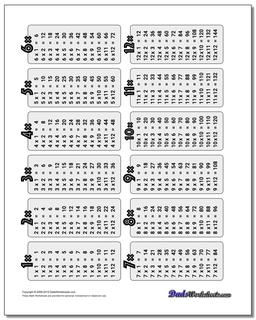
Color Single Fact Multiplication Tables
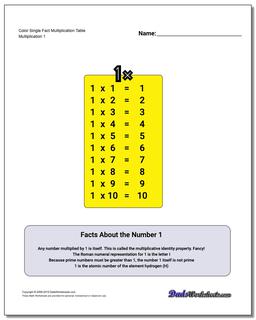
Color Single Fact Multiplication Tables Worksheets
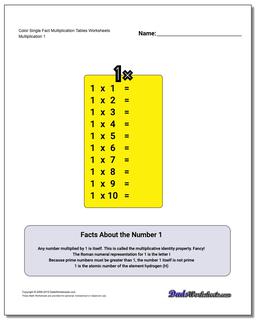
Single Fact Multiplication Table
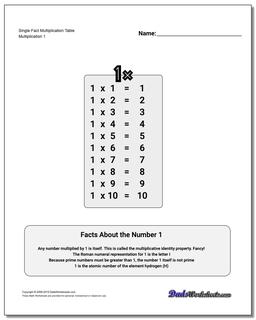
Single Fact Multiplication Tables Worksheets
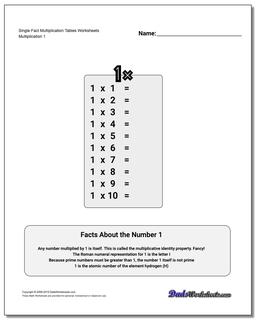
Printable Multiplication Tables
Learning the multiplication tables is one of the milestone skills in primary grade mathematics. It's one of the first activities that requires memorizing a large number of facts. This process is different from memorizing spelling words where there are often phonetic hints or other clues that at least get you started. Numbers are abstract and learning that 6x7 is 42 might as well seem like random gibberish to a student.
The printable multiplication tables you will find here provide the most basic overview of sets of multiplication facts, either as individual multiplication fact tables or as a simple multiplication table worksheet for building early familiarity with a family of multiplication facts.
Multiplication tables provide a convenient bridge from skip counting (or incremental addition) to mastery of the full set of multiplication facts. Because multiplication tables present the facts in a structured way, they can help put the entire concept of multiplication into a context that many students grasp more readily than rote memorization. Seeing the multiplication facts arranged sequentially can often help a student see the internal number patterns that make up each fact group. Later, seeing the facts as part of a multiplication chart can expose them to number patterns that occur across sets multiplication facts as well.
There are blank multiplication table worksheets on this page that allow the students to use skills like skip counting to fill in the answers for each multiplication fact group. When filled in, they can be then be used as a reference aid, or there are complete multiplication tables that you can print out either for individual sets of facts or for the entire multiplication table. Students can use these to look up answers until they master their multiplication facts based around a given number.
While most multiplication table practice tends to focus on the facts with products from 1-100, you will find the more advanced facts here including the much dreaded times 12 multiplication table. Many instructors view some of these facts as superflous given the advent of calculators and cell phones these days, but our continued reliance on measurements that are not strictly based on units of ten (for example, time or angular measurement) makes memorizing both the times 15 multiplication table and times 12 multiplication table useful for many mental calculations.
Tricks for Learning the Multiplication Table
If you are starting out with a 10x10 multiplication table with results 1-100, there winds up with an intimidating number of facts. Fortunately, there are many extra tricks for learning the multiplication table, and you can find a summary of them in my Eight Rules for Mastering the Times Tables post. Use these rules to help get to a product quickly until your grade school student has the facts memorized. A quick recap is below:
- The facts are the same no matter what order the arguments are in (the first times the second gives the same result as the second times the first). This cuts the number of multiplication table facts in half effectively.
- Because of a property called identity, any number times one is itself, and because of the first rule, that eliminates an extra fact from each of the other multiplication tables as well.
- Multiplying by two is the same as doubling addition. If you know a few basic addition facts, the times 2 multiplication table is easy, and again, keep in mind the first rule, and this knocks the Nx2 problems from all the other tables as well.
- Times times 4 multiplication table can be solved by doubling twice.
- To solve for problems in the 5 times table, simply skip count by fives.
- The product for a times 9 multiplication table fact is found by taking the number and subtracting one, use that number in the tens place of the product, and for the ones place start with 9 and subtract the digit you just found for the tens place. Another way to think of this is that for any nines table fact less than 100, the sum of the digits is always going to be be nine.
- For times ten multiplication facts, add a zero to the end to get the product.
- There are a few remaining multiplication able facts that don't fit the rules, and these need to be memorized. Fortunately most of these are easy. 3x3=9, 3x6=18, 3x7=21,3x8=24, 6x6=36, 6x7=42, 6x8=48, 7x7=49, 7x8=56, 8x8=64.
You'll notice that most of the multiplication table facts that need to be memorized come from the times 3 multiplication table and the times 7 multiplication table. Giving students extra practice with those tables will help, but there are also worksheets that focus just on those facts in the Dad's Rules for Multiplication section of this site.

Copyright 2008-2024 DadsWorksheets, LLC
Filter Results
- clear all filters
Resource Type
- Worksheets
- Guided Lessons
- Lesson Plans
- Hands-on Activities
- Interactive Stories
- Online Exercises
- Printable Workbooks
- Science Projects
- Song Videos
middle-school
- Fine arts
- Foreign language
- Number Sense
- Addition
- Subtraction
- Multiplication Strategies
- Multiplication Facts
- One-Digit Multiplication
- Multi-Digit Multiplication
- Properties of Multiplication
- Division
- Mixed Operations
- Fractions
- Decimals
- Percents, Ratios, and Rates
- Algebra
- Geometry
- Measurement
- Time
- Money Math
- Data and Graphing
- Math Word Problems
- Math Puzzles
- Reading & Writing
- Science
- Social emotional
- Social studies
- Typing
- Holidays
- Offline games
- Pop Culture & Events
- Seasonal
- Teacher Resources
- Common Core
Multiplication Worksheets and Printables
Multiplication quick links :.

Good Times Await with Multiplication Worksheets

Reading & Math for K-5
- Kindergarten
- Learning numbers
- Comparing numbers
- Place Value
- Roman numerals
- Subtraction
- Multiplication
- Order of operations
- Drills & practice
- Measurement
- Factoring & prime factors
- Proportions
- Shape & geometry
- Data & graphing
- Word problems
- Children's stories
- Leveled Stories
- Sentences & passages
- Context clues
- Cause & effect
- Compare & contrast
- Fact vs. fiction
- Fact vs. opinion
- Main idea & details
- Story elements
- Conclusions & inferences
- Sounds & phonics
- Words & vocabulary
- Reading comprehension
- Early writing
- Numbers & counting
- Simple math
- Social skills
- Other activities
- Dolch sight words
- Fry sight words
- Multiple meaning words
- Prefixes & suffixes
- Vocabulary cards
- Other parts of speech
- Punctuation
- Capitalization
- Narrative writing
- Opinion writing
- Informative writing
- Cursive alphabet
- Cursive letters
- Cursive letter joins
- Cursive words
- Cursive sentences
- Cursive passages
- Grammar & Writing
Breadcrumbs
- Math by topic
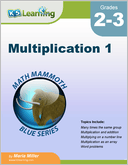
Download & Print Only $5.60
Multiplication Worksheets
Multiplication worksheets for grades 2 to 6.
Our multiplication worksheets start with the basic multiplication facts and progress to multiplying large numbers in columns. We emphasize "mental multiplication" exercises to improve numeracy skills.
Choose your grade / topic:
Grade 2 multiplication worksheets, grade 3 multiplication worksheets, grade 4 mental multiplication worksheets.
Grade 4 multiply in columns worksheets
Grade 5 multiplication worksheets
Grade 6 multiplication worksheets.
Multiplication facts: drills and practice
Multi-digit multiplication: drills and practice
Multiplication flashcards
Topics include:
- Meaning of multiplication
- Multiplication Facts 2 & 3, 5, 10, 2-5
- Multiplication Tables of 2, 5 & 10
- Multiplication tables - missing factors
- Two times small numbers
- Two times multiples of 5
- Two times whole tens
- Two times whole tens (missing factors)
- Multiplication word problems (within 25)
- Multiplication sentences
- Multiply with arrays
- Multiply using a number line
- Multiplication facts (various practice up to 2-12)
- Multiplication tables
- Multiplication facts (missing factors)
- Multiplying 1-digit numbers by whole tens
- Multiplying 1-digit numbers by whole hundreds
- Multiply whole tens by whole tens
- Multiply whole tens (missing factors)
- Multiply in columns (1-digit by 2-4 digits)
- Multiplication word problems
- Multiplication tables 2-10, 2-12, random facts
- Multiplication tables 2-10, 2-12, missing factors
- Commutative property
- Distributive property
- Multiply 1-dit numbers by whole tens or hundreds
- Multiplying whole tens by whole tens (including missing factors)
- Multiply whole tens, whole hundreds and whole thousands
- Multiply 1-digit numbers by a number close to 100
- Multiply in parts (1-digit by 2 or 3 digits)
- Mixed multiplication and division word problems
- Mixed 4 operations word problems
Grade 4 multiplication in columns worksheets
- Multiply in columns 1-digit by 2, 3 or 4 digits
- Multiply in columns 2-digits by 2, 3 or 4 digits
- Multiply in columns 3 digit by 3 digit
- Multiply by 10, 100 or 1,000 with missing factors
- Multiplying in parts (distributive property)
- Multiply 1 digit by 3 digit numbers mentally
- Multiply in columns up to 2x4 digits and 3x3 digits
- Multiplying in columns up to 5 digit numbers
Related topics
Division worksheets
Fractions worksheets

Sample Multiplication Worksheet
What is K5?
K5 Learning offers free worksheets , flashcards and inexpensive workbooks for kids in kindergarten to grade 5. Become a member to access additional content and skip ads.

Our members helped us give away millions of worksheets last year.
We provide free educational materials to parents and teachers in over 100 countries. If you can, please consider purchasing a membership ($24/year) to support our efforts.
Members skip ads and access exclusive features.
Learn about member benefits
This content is available to members only.
Join K5 to save time, skip ads and access more content. Learn More
- Forgot Password?
Times tables worksheets

Mixed worksheets
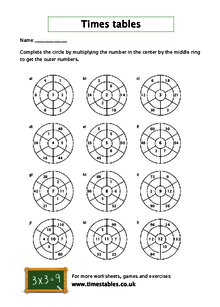
Printable times tables quiz generator
Times tables worksheet, name:_____________, timestables.co.uk, answer sheet.
Would you like to practise your tables? Below you will find tables practise worksheets. Click on one of the worksheets to view and print the table practice worksheets, then of course you can choose another worksheet. You can choose between three different sorts of exercises per worksheet. In the first exercise you have to draw a line from the sum to the correct answer. In the second exercise you have to enter the missing number to complete the sum correctly. In the third exercise you have to answer the sums which are shown in random order. All in all, three fun ways of practicing the tables in your own time, giving you a good foundation for ultimately mastering all of the tables. Choose a table to view the worksheet.
Practise with tables worksheets
A great addition to practising your tables online is learning them with the assistance of worksheets. Here you can find the worksheets for the 1, 2, 3, 4, 5, 6, 7, 8, 9, 10, 11 and 12 times tables. You can also use the worksheet generator to create your own worksheets which you can then print or forward. The tables worksheets are ideal for KS1 and KS2 practise.

Register an account for free
And view your medals and diplomas in the trophy cabinet!
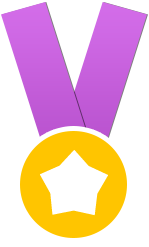
Username: (?) (Pay attention to privacy and don't use sirnames.) Only letters and numbers Password: Please re-enter your password:
Username: Only letters and numbers Password:

Addition (Basic)
Addition (Multi-Digit)
Algebra & Pre-Algebra
Comparing Numbers
Daily Math Review
Division (Basic)
Division (Long Division)
Hundreds Charts
Measurement
Multiplication (Basic)
Multiplication (Multi-Digit)
Order of Operations
Place Value
Probability
Skip Counting
Subtraction
Telling Time
Word Problems (Daily)
More Math Worksheets
Reading Comprehension
Reading Comprehension Gr. 1
Reading Comprehension Gr. 2
Reading Comprehension Gr. 3
Reading Comprehension Gr. 4
Reading Comprehension Gr. 5
Reading Comprehension Gr. 6
Reading & Writing
Reading Worksheets
Cause & Effect
Fact & Opinion
Fix the Sentences
Graphic Organizers
Synonyms & Antonyms
Writing Prompts
Writing Story Pictures
Writing Worksheets
More ELA Worksheets
Consonant Sounds
Vowel Sounds
Consonant Blends
Consonant Digraphs
Word Families
More Phonics Worksheets
Early Literacy
Build Sentences
Sight Word Units
Sight Words (Individual)
More Early Literacy
Punctuation
Subjects and Predicates
More Grammar Worksheets
Spelling Lists
Spelling Grade 1
Spelling Grade 2
Spelling Grade 3
Spelling Grade 4
Spelling Grade 5
Spelling Grade 6
More Spelling Worksheets
Chapter Books
Charlotte's Web
Magic Tree House #1
Boxcar Children
More Literacy Units
Animal (Vertebrate) Groups
Butterfly Life Cycle
Electricity
Matter (Solid, Liquid, Gas)
Simple Machines
Space - Solar System
More Science Worksheets
Social Studies
Maps (Geography)
Maps (Map Skills)
More Social Studies
Mother's Day
Father's Day
More Holiday Worksheets
Puzzles & Brain Teasers
Brain Teasers
Logic: Addition Squares
Mystery Graph Pictures
Number Detective
Lost in the USA
More Thinking Puzzles
Teacher Helpers
Teaching Tools
Award Certificates
More Teacher Helpers
Pre-K and Kindergarten
Alphabet (ABCs)
Numbers and Counting
Shapes (Basic)
More Kindergarten
Worksheet Generator
Word Search Generator
Multiple Choice Generator
Fill-in-the-Blanks Generator
More Generator Tools
Full Website Index
Multiplication Worksheets (Basic Facts 0-10)
We have multiplication sheets for timed tests or extra practice, as well as flashcards and games. Most resources on this page cover basic multiplication facts 0-10.

Worksheets and Games

Logged in members can use the Super Teacher Worksheets filing cabinet to save their favorite worksheets.
Quickly access your most used files AND your custom generated worksheets!
Please login to your account or become a member and join our community today to utilize this helpful feature.

Multiplication Tables (Multiplication Charts)
Mystery pictures, basic multiplication worksheet generator.
Make your own basic multiplication worksheets. You choose the range for the first and second factor. This generator allows you to create worksheets with 25 or 50 problems.
Timed Quizzes
Multiplication drills, multiplication arrays, fact families.

Properties of Multiplication
We have thousands of multiplication worksheets. This page will link you to facts up to 12s and fact families. We also have sets of worksheets for multiplying by 3s only, 4s only, 5s only, etc.
Practice more advanced, multi-digit problems.
Print basic multiplication and division fact families and number bonds.
Practicing skip counting skills can help students master their multiplication facts.
Practice using the the distributive, associative, commutative, and identity properties of multiplication.

Multiplication Worksheet Images
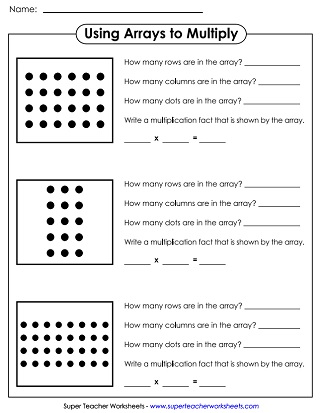
PDF with answer key:
PDF no answer key:
20 Multiplication Worksheets for Effective Math Practice
Written by Laney Kennedy
- Teacher Resources,
- Teaching Tools
You’ve done the hard work to make multiplication easy for your students. Now, it’s time for them to practice everything they’ve learned with multiplication worksheets.

- 20 Printable multiplication worksheets
- 5 Fun ways to use multiplication worksheets in the classroom
- How to use Prodigy Math to teach multiplication
You’ve done the hard work to make multiplication easy for your students. Now, it’s time for them to practice everything they’ve learned with multiplication worksheets .
Worksheets aren’t the only way to practice multiplication, but they’re an effective, easy way to work on class material and get students working independently. Plus -- while students complete their worksheets, you have time to catch up on other important tasks.
The only problem is creating them. We know it can be time-consuming to make your own worksheets -- so we’ve created them for you!
We’ve got 20 free multiplication worksheets for third and fourth grade, covering a variety of skills for students to practice.
We'll cover the following:
Multiplication worksheets -- grade 3
- Multiplication Facts (0-9)
- Multiplication Tables (0-12)
- Multiply multiples of 10
- Multiplication properties
- Multiplication word problems
- Multiplication word problems - arrays
Multiplication worksheets -- grade 4
- 2 digit by 1 digit multiplication
- 2 digit by 2 digit multiplication
- 4 digit by 1 digit multiplication
- Multiplication as a comparison
Each of our worksheets come with an answer key for your reference, and students can complete them with or without the help of a multiplication chart . Just choose the grade level and skill that’s right for your class and then click to download.
Check out our multiplication worksheets below!
Can't decide?
Download all of our grade 3 worksheets here!
Download all of our grade 4 worksheets here!
Sometimes assigning your students worksheets can feel stale, but there are plenty of fun ways you can use them to liven up your lessons!
Here are some ways you can use multiplication worksheets in your class that are sure to keep students engaged.
1. Think-pair-share
Think-pair-share is a learning strategy designed to enhance students’ understanding of concepts and encourage collaboration with peers. It’s also a great way to conduct formative assessments . Students think about a concept individually, pair up to discuss their ideas, and then share their thoughts with the class.

Image source: Giulia Forsythe on Flickr
Here’s how to use think-pair-share with your multiplication worksheets:
- Think — Give each student a multiplication worksheet and let them work individually to solve all the problems.
- Pair — Split your class into pairs and have them compare answers, solving any differences and discussing trouble spots.
- Share — Take up the questions as a class and encourage each pair to participate by offering at least one answer. You can also facilitate discussions about difficult questions or thought processes for solving each equation.
2. Learning stations
Make multiplication worksheets a math stop in your next learning station rotation.
Learning stations are a popular blended learning technique -- usually incorporating technology, worksheets and hands-on activities -- so students can interact with different instructional models and learning environments. It also helps you fit more learning into your already busy workday.
Learning stations can take many forms. For example, if you want to focus on multiplication in your next rotation, try including the following:
- Multiplication worksheets
- Small group instruction
- Flashcards for multiplication fact fluency
- Digital learning tools like Prodigy Math
- Multiplication games like mystery picture or multiplication war
- Multiplication crafts like this one from Teachers Pay Teachers
3. Team battles
Turn your worksheets into a class battle to encourage friendly competition in your classroom.
Split the class into pairs or teams and let them battle to complete the questions on their worksheets first.
You can get creative when choosing the size of each team, time limits, how teams will show they’ve completed the worksheet, and prizes for the winners.
4. Scavenger hunt
Turn any worksheet into a treasure map by making a multiplication scavenger hunt!
Give students a checklist of certain numbers or elements to look for in their worksheets. As they solve the worksheet, they can check off the items in their list until both the worksheet and the scavenger hunt is complete.
For example, have students find a product with:
- 2 even numbers and 2 odd numbers
- Only one even number
- 3 in the hundreds place
- The sum of 5 and 7
Try including lots of different elements in your scavenger hunt and going beyond using just numbers. You can offer additional incentives such as bonus marks or prizes for students who finish their scavenger hunts.
5. Mystery number
This activity is similar to a scavenger hunt, but instead of a list, students are only looking for one mystery number.
Give students a mystery number to find somewhere in their multiplication worksheets and then have them write the equation that produced it.
You can turn this task into a group competition as well, having teams battle to write the equation with the mystery number on the board first.
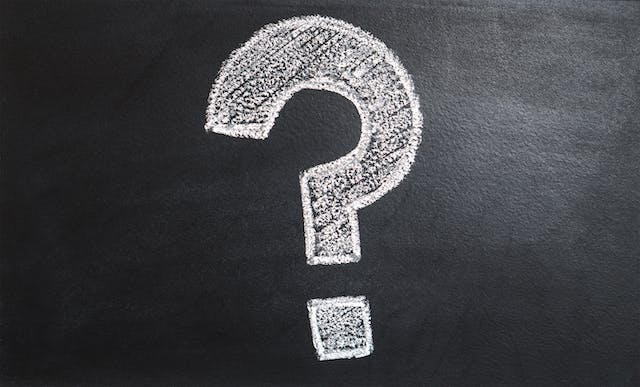
Tip: To make the activity more challenging, give clues for the mystery number instead of giving the actual number.
To supplement worksheets, use Prodigy in your multiplication lessons.
Prodigy is an engaging game-based learning platform that targets curriculum-aligned math skills (including multiplication) for 1st-8th grade students around the globe.
There are so many ways to teach multiplication with Prodigy.
- An online multiplication game
- A math learning station
- Homework assignments
- A personalized learning tool with adaptive feedback
- Entry or exit tickets
- A classroom reward (that still involves learning!)
Final thoughts: multiplication worksheets
Worksheets are just one of many methods for getting your students to practice multiplication and other important concepts. They’re also great for conducting formative assessments or assigning homework.
Print out these multiplication worksheets to plan a dynamic, engaging math class and give your students some powerful multiplication practice. Our worksheets will be a perfect addition to your multiplication lessons!
Create or log into your teacher account on Prodigy Math — an engaging, game-based learning platform for math that's easy to use for educators and students alike. Aligned with curricula across the English-speaking world, it's loved by more than 100 million teachers and students.
Share this article
Table of Contents
Bonus teaching tip
Use Prodigy Math's adaptive algorithm to help your students advance their multiplication skills, all while having fun!

Multiplication Tables Check
This activity exactly mirrors the 'Multiplication Tables Check' that will be given to children at the end of Year 4. They are tested on their multiplication tables up to 12 x 12. There are twenty-five questions and children have six seconds to answer each question and three seconds between questions. The questions are generated randomly using the same rules as the 'Multiplication Tables Check' (see below).
Results can be downloaded and printed at the end of the test.
A similar activity which tests recall of number bonds can be found here.
For more multiplication games click here.
|
|
|
|
| 1 | Not applicable | Not applicable |
| 2 | 0 | 2 |
| 3 | 1 | 3 |
| 4 | 1 | 3 |
| 5 | 1 | 3 |
| 6 | 2 | 4 |
| 7 | 2 | 4 |
| 8 | 2 | 4 |
| 9 | 2 | 4 |
| 10 | 0 | 2 |
| 11 | 1 | 3 |
| 12 | 2 | 4 |

- Grades 6-12
- School Leaders
Get our FREE 'Meet the Teacher' bundle!
50 Fun Hands-On Activities and Games To Teach Multiplication
Help your students become multiplication masters.
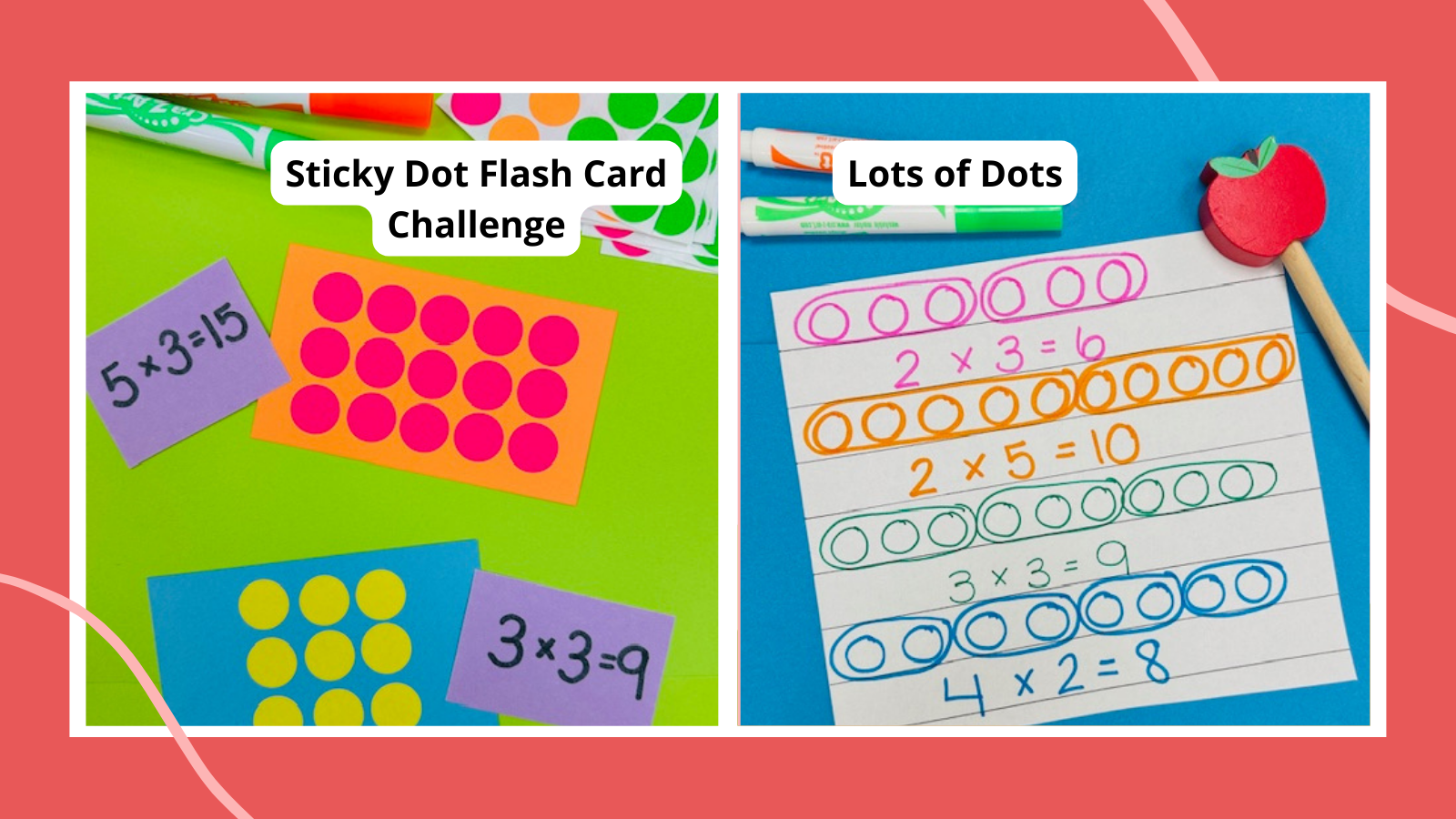
hand2mind believes children learn best by doing. Energize your classroom for the year with the latest tools and resources!
A lot of math has to do with answering the same question: “How many?” You can count, you can add, you can skip-count, but one of the most efficient and accurate ways to answer the question is by grouping things together and multiplying. It’s a skill we use every day in real life throughout our lives, and the activities below are a fun way to teach students multiplication.
We help young learners understand how multiplication works by hands-on exploration at first, through pictorial work, and eventually to the most efficient strategy of all: memorization of multiplication facts for easy recall. Here are some great ways to teach multiplication to get your students excited and engaged from the beginning of understanding to multiplication mastery.
Sticky Dot Flash Card Challenge
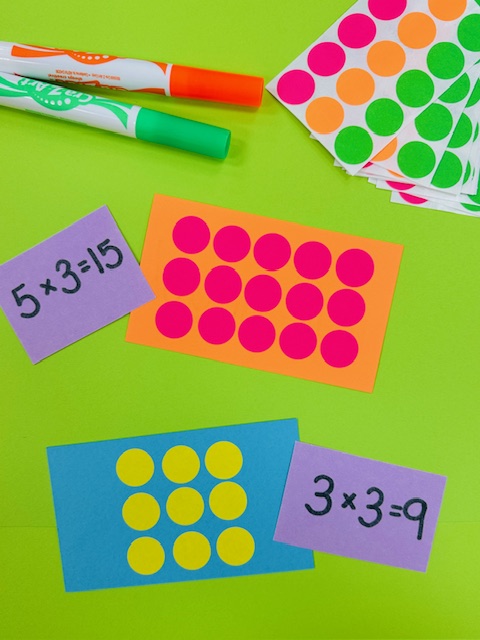
Purchase a few sets of colorful sticky dots. On pieces of card stock or construction paper, arrange sticky dots in arrays that model multiplication facts. For example, to show 3 x 4, make three rows with four dots in each row. Then have students make these on pieces of card stock with the dots on one side and the multiplication fact written on the back. Once students have made a set of at least 12 cards, have them meet with a partner to play a game. The first player flashes a card with dots showing for two seconds. The second player must try to quickly guess the fact and answer. The lead player takes the card out and shows both sides to check the answer. Have students take turns flashing cards and working through the deck.
Human Body Multiplication
Everybody has two ears, but how many ears do three students have all together? Practice multiplication by calling up three students to the front of the classroom. Ask questions for the whole class that focus on multiplying such as, “How many ears does this group have all together (3 x 2 = 6)?” “How many fingers does this group have all together? (3 x 10 = 30)?” “How many noses do they have all together (3 x 1 = 3)?” As you ask, have the rest of the class write the multiplication problem and the product on a whiteboard or paper and share their answers. Give all students a chance to come up and be part of the multiplying group. Change the number of students in the modeling group to change the resulting facts.
Marvelous Multiplying Martians Poem
Supply each student with a set of 20 counters. Then read this poem and sub in two numbers in the blanks as you read. Students use their counters to model the problem and find the answer.
Early in the morning, ___ Martians came. They multiplied by ___ and played a football game. When earthlings saw them playing, the whole crowd shouted, “Wow!” Just how many Martians do you think are playing football now?
Try various numbers and have kids rhyme along with you. You can write the poem on a chart for all to read along.
Clapping Facts
Here’s a good listening and math game. Tell students you will clap out a multiplication fact. They should listen carefully to the number of claps, and write the fact they hear down on a whiteboard or paper. For example, for 2 x 7, you would clap like this:
Clap, clap, clap, clap, clap, clap, clap (pause)
Clap, clap, clap, clap, clap, clap, clap (stop)
For 3 x 3 it would sound like this:
Clap, clap, clap (pause)
Clap, clap, clap (stop)
Ask students to share their answers. After you’ve done a few, have students take turns choosing facts and leading the clapping. Write all the facts you’ve done on the board so there won’t be any repeats.
Multiplying Card Game
Using index cards, have each student create a set of digit cards from 0 to 10 with five copies of each digit card in the deck. Then ask students to partner up and put one deck in the middle. The lead player shuffles the deck and then deals two cards to each player. After that, players multiply their two cards and announce their individual products. Whoever has the highest product wins all four cards. The player with the most cards at the finish of the deck wins.
Multiplication Model Make-It
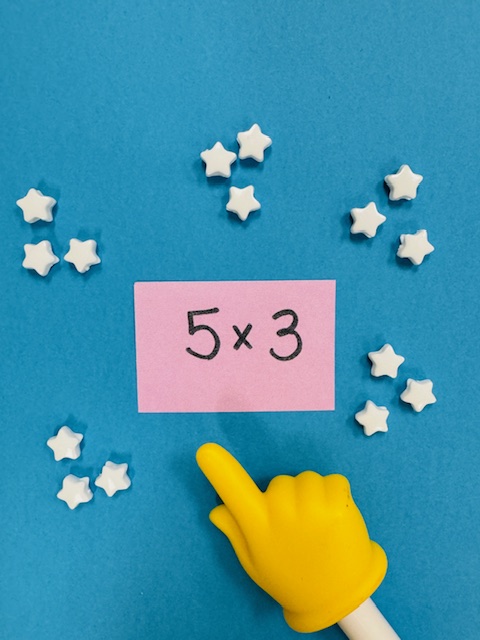
Kids like to get their hands on things and move them around. Keeping learning active is always a great strategy with kids. Here’s a good way to do that and practice multiplication.
Provide each student with a group of small manipulatives such as cubes, counters, beads, or even dried beans (very cheap and they work well!). Then call out a multiplication fact and ask students to group their manipulatives to model the fact. For example, if you call out 5 x 5, students will create five groups of five beans in each. After they complete this task, ask them to announce the product. Students can take turns leading this activity as well.
Calculator Checker
Give students simple calculators. It’s good to give your class practice with how calculators work. Call out two factors, like “3 and 7.” Students input the two factors on the calculator, pushing the x button in between, but they don’t press the = button. Wait 30 seconds while students think about the answer. Then ask for possible answers. After everyone has a chance to respond, tell students to press the = button to check their answers. Let students take turns leading this game.
Multiplication Shake
Ask each student to bring in an empty egg carton. In the bottom of each section of the carton, have them write a number from 0 to 11 with a permanent marker. Give each player two beans or beads. Players put the beads in their boxes and close them tight. When you say go, they shake the box. When you say stop, they open the box and multiply the two numbers where the beads landed. Each player raises their hand and shares the fact they came up with along with the product. You can ask things like, “Who has the highest product?” “Who has the lowest product?” “Who has an odd or even product?” and then try it again.
Hole-Punch Multiplier
Arrays are a great way for students to “see,” and in this case “feel,” multiplication facts. This is a good activity to individualize that multiplication work. Divide a white piece of card stock into eight boxes. In each box write a multiplication fact you would like the student to work on. Give them another piece of card stock that’s a different color and a hole punch. Ask them to create an array in a piece of the colored paper that shows the multiplication fact in each box. Then have them glue that array into the correct box. Have them flip the paper over and complete eight more.
Challenge Roll
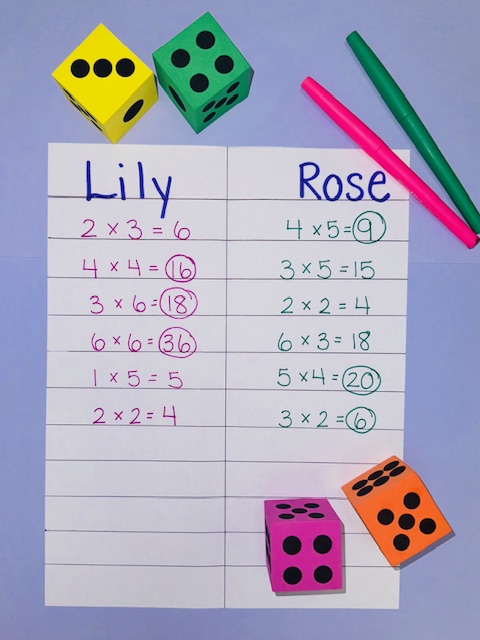
Partner students up. Give each group a pair of dice, lined paper, and a pencil. They should fold the paper in half vertically and write their names at the top of the two columns. Have players take turns rolling the dice and recording the two numbers that come up as factors on the paper in their column. They then multiply these together and write the product. Whoever rolls the highest product in each round wins that round and circles their winning product. You can also play it with the lowest product as the winner. Instead of dice, you can also play this with number cubes marked from 0 to 5 and 6 to 11. You can convert dice to number cubes by putting white sticky dots on each side and writing the numbers you want on them.
Multiplication Museum
Provide a variety of manipulatives like counting chips, cubes, paper clips—almost anything you have plenty of. Also give each student 10 index cards and tell them that they will be setting up their own multiplication museums on their desks using the manipulatives. Each museum should have at least 10 exhibits. An exhibit consists of an arrangement of manipulatives to represent a specific multiplication fact. For example, to show 3 x 7, you might make three cube towers with each one made of seven cubes. Then they fold an index card in half, write the multiplication fact on it, and stand it up as the “exhibit sign.” Finally, have students visit one another’s museums when they are all completed.
Partner students up and put a deck of multiplication fact cards down in between them. After that, each student takes a turn picking a card. They do not look at the card, but rather hold it against their forehead so their partner can see the card. The partner tells the lead player the product for that fact. For example, if I pick a card that says “3 x 5,” my partner would say, “You’re 15.” Now I have to guess the factors on the card by saying, “I’m 3 x 5.” There are sometimes more than one way to make a product, however. If I said, “I’m 5 x 3,” my partner would say, “No, you’re not. Guess again.” This can really be fun while developing strong mental math and listening skills.
Twister Multiplication
Maybe you have the old classic game Twister at home. If not, check out the thrift shops or online sellers. Take a set of sticky notes, and on each one, write a multiplication fact on one half and the product on the other. Cut them in half. On the Twister spinner, there are color dots. Place the product part of the sticky fact on the spinner dots. On the Twister mat, place the other half of the fact cards on those dots. As you spin, each student will call out the product the spinner points to. Players on the mat have to try to place a hand or foot on the fact that makes that product. Active, fun, and a bit crazy, but it’s a great way to practice multiplication facts.
Multiplication Mix-Up
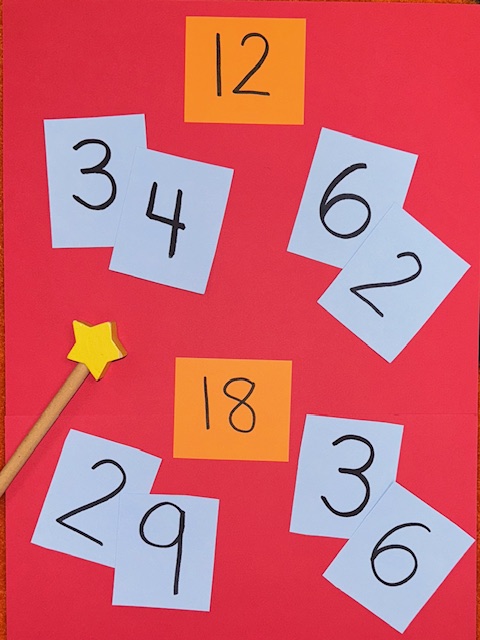
Take index cards and make a set of digit cards 0 to 9 with at least three of each card. Have students shuffle their cards and spread them out on their desks. Call out a product, like 12. Give students three minutes to find pairs of cards that if multiplied together would result in that product. With the product of 12, students should be able to show you the following pairs: 2 x 6, 6 x 2, 3 x 4, and 4 x 3. After a round, ask players to reshuffle and then announce the next product.
Tower of Facts
Use an old Jenga set or pick up a generic one at a dollar store. On each block, use a permanent marker to write a multiplication fact. Then set up a tower. As players pull blocks from the tower, they must answer the multiplication fact on the block. If they are correct, they keep the block, and if they are wrong, all partners get a chance to answer. If all miss, the block gets stacked back up on top. It’s a cooperative game as no one really wants that tower to fall. (Or do they?)
Name Tag Sort
Get a pack of sticky name tags and write multiplication facts you want to practice on each one. Pass out a tag to each student and have them put it on. Begin to call out sorting clues. If a student’s product matches the sort clue, they stand up. If not, they stay seated. Sorting clues include things like “all odd products, all even products, both factors are odd, both factors are even, the product is more than 15, the product is less than 15,” and so on. Let students take turns leading this one.
Multiplication Cup Towers
Buy a set of small disposable plastic bathroom cups. On the side of each one, write a multiplication fact. This is a good activity for a small group of three or four students. Put the set of cups in the middle of the group. Have students take turns pulling a cup. If they answer the fact correctly, they keep the cup and can begin to build a stacking tower. If they miss it, they put the cup back in the middle. Limit play by the number of times you can pull a cup (10 is a good start) or time (two minutes is reasonable).
Lots of Dots
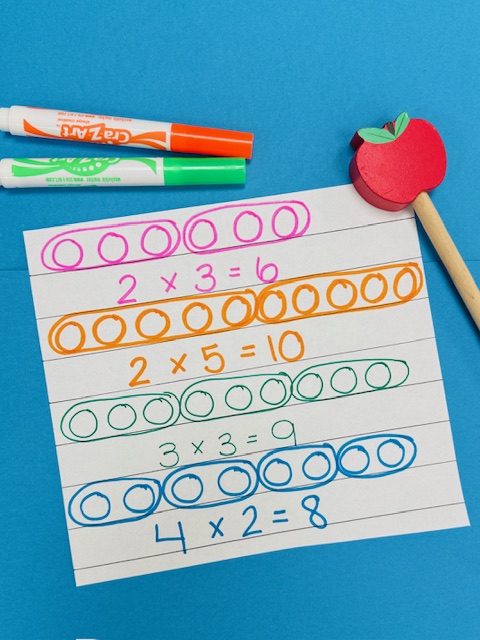
Kids love this simple activity. Give each student a lined paper and a pencil. Tell them to draw a given target number of dots, like 12. After each student does this, ask them to take a crayon and circle the dots in a way that will reveal a multiplication fact. For example, with 12, they might circle two groups of six or six groups of two or three groups of four, and so on. They then write the facts underneath the dots. This calls for careful counting and, of course, knowing some facts!
Domino Multiplication War
Partner up students and give them a set of dominoes. The dominoes should be placed in a box or bag so players can’t see them. Players take turns picking a domino out of the bag. The first player checks both sides of the domino and chooses the side that would yield the largest product when the two dot arrays are multiplied together. They put it face up in the middle. The next player picks a domino and does the same thing. The player with the largest product wins and keeps both dominoes. Play continues until the bag or box is empty. Then players count their dominoes to see who has the most. You can also play this one to try to get the lowest product. Either way is lots of fun.
Bottle Cap Facts
Have students collect bottle caps, wash them, and bring them into class. Distribute the bottle caps evenly among the class. Give students a multiplication fact assessment of the 100 multiplication facts and score them together. Have students circle the facts they missed. Then give them a black fine-point permanent marker and a set of sticky dots. Ask them to write any missed facts on the sticky dots (or facts they found hardest) and attach it to the top of a bottle cap. On the inside of the cap, they write the product.
You can play all kinds of games with bottle caps, but one fun one is to have players trade sets and push a cap to the middle. The player who created that fact set has to answer the fact question. If they’re correct, they get the cap and a point. This allows players to practice facts they found difficult in a game format.
Have a Ball Multiplying Hard Facts
Ask your class what the most difficult multiplication facts to remember are. Write these on the board. Brainstorm strategies to remember them together. Write these strategies next to the hard facts on the board. Then get a soccer ball and write these hard facts on the ball (or balls) with permanent marker. Form a circle and toss the ball to a student. Whatever fact their right thumb lands on is the fact they should answer. Have them refer to the board and the strategies if they are unsure. Take turns tossing the ball around the circle, making sure everyone gets a turn.
Rock, Paper, Multiply!
This game looks like it’s going to be Rock, Paper, Scissors, but it’s not. Partner students up and have them stand and face each other. On the count of three, each player throws out a number of fingers on one hand. Both players look at the fingers, count them, and multiply those two numbers. The first with the correct answer is the winner. As players get more skilled, have them play with two hands each.
Multiplication Clue Cards
Give each student two blank index cards and two multiplication facts. Students should write the two factors down on one side of each card. On the other side, they should write at least three clues that will point other players to what the multiplication fact is. For example, if you give me the fact 3 x 3 = 9, I could write clues like: 1. “Both factors are the same.” 2. “The factors are less than 4.” 3. “The product is odd.” Students take turns reading their clues to the class, while classmates try to guess the fact.
Product Call-Out
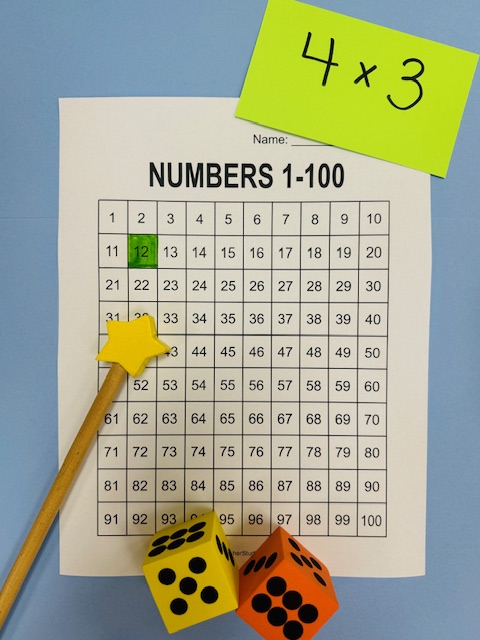
Give each student a copy of a 100 chart and a set of crayons or colored pencils. Then give directions to have students color and locate products for the multiplication fact you call out. For example, when you call out 3 x 5, students should color the number 15 on their charts. This is a great way to emphasize multiplication patterns by calling out all of the facts with a certain factor in a row. For example, you might ask for 3 x 3, 3 x 6, 3 x 2, 3 x 7, and so on. You could call them in order or mix them up a bit like the ones just mentioned. You can use different colors for different fact families if you like.
Multiplication Fact Bingo
Provide each student with a 100 Multiplication Facts Chart. These charts have the factors but not the product. Tell students you will be playing Multiplication Bingo together. You will call out a product, and they must find the fact on their paper and color it in with a light-colored color pencil or crayon so we can still see the facts. When they get three in a row in any direction, they should circle the three and call out, “Bingo!” Write the three facts and products on the board to help everyone check their work. Keep playing on that same sheet and play for as many bingos as you like.
Give each student a blank 15 x 15 array sheet or a sheet of graph paper, pencil, and crayons or colored pencils. Model how you would draw an array for a multiplication fact on a paper like this. For example, if the target fact is 3 x 7, you could draw a rectangle that is three squares across and seven squares down. Outline it in pencil, write the fact and product on the rectangle, and color over it lightly. Explain to students that they should draw and color a rectangular array for each multiplication fact you announce.
The goal for the student is to arrange their arrays to try to cover up as many spaces as possible. After 10 facts are called out, the winner is the person with the least amount of white squares left. Caution students that sometimes they may be unable to make an array that you call because there isn’t enough space left. If that’s the case, they wait until the next fact is called.
Partner students up and give them a set of multiplication fact cards. The lead partner deals out 10 cards to each player. Two cards are then picked at random from the deck and placed on a desk about 2 feet apart. These are the beginning and end cards. Their products signify the beginning and end of a number line. So, if the two cards are 2 x 5 and 6 x 4, the number line stretches from 10 to 24.
Now players fan out their cards with the facts hidden. The lead player picks a card from their partner’s fan and places it on the number line if they can. If you pick an 8 x 6 card, you can’t place it on the number line going from 10 to 24 because the product is 48, so you put it in your deck. Players take turns picking cards and trying to place them. After 10 picks, players count up their cards. The player with the least cards wins.
Multiplication Stories
Give students a lined piece of paper and a pencil, and have them fold it into four squares. Then write four multiplication facts on the board. Ask students to copy the facts at the top of each square. Explain that they should write a short story problem that fits each fact. For example, if I had to write about 5 x 5, I might write something like, “There were five brothers. Each one had five books. How many books did they have all together?” Urge students to be creative. These can get pretty funny. Take turns sharing the problems aloud. Finally, on the back of the paper, have students choose four facts of their own and write stories about those. These are great word problems to use as a source for for tests and quizzes. Give students a “byline” on the paper next to their problem.
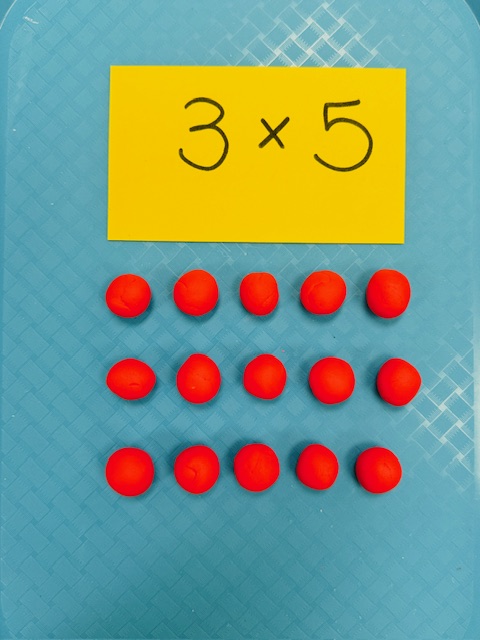
(Cl)Arrays are arrays made out of clay (ha, ha!). Kids love to get their hands on and in clay or play dough so let them go at it while they practice multiplication. Each student gets a good-size ball of clay and a mat to work on. Plastic place mats work well. Write a “Feature Fact” on the board. Each student takes their clay and, making smaller balls, creates an array that matches that fact. Give students a turn to lead and pick the featured fact. You can also feature two or three facts at a time. Emphasize how the first factor tells us how many groups and the second factor tells us how many in a group.
Find That Fact!
Write about 20 multiplication products on the board. Then have two students come up. Explain that you will call out a fact, and players must point to the product that matches your fact as quickly as possible. Whoever points to the fact first wins that round and stays at the board. Keep sending players up until everyone has a turn.
Multiplication Flower Garden
Math and art, they go together. Here’s a decorative way to practice a set of facts. Draw a flower with 12 petals and a circle in the center. Then write the factor for a fact family you want to practice in the center circle, and draw 12 petals and number them 1 to 12. These are the second factors. On the outside of these petals, draw larger petals and write the products of the center and the first petal. Now color. Makes a great math display. Assign different fact families to different students so you can have a complete garden!
Multiplication War
Partner students up and give them a deck of playing cards. Then have the lead player deal out the complete deck face down to each player. Players each flip two of their own cards, multiply them, and say the product aloud. The player with the higher product wins that round and all the cards in the round. Play is complete when all cards have been dealt. Now it’s time to add up the cards to see who wins!
Addition and Multiplication Scramble
Multiplication is really repeated addition but done in a very efficient way. Write a repeated addition sentence on the board, like 5 + 5 + 5 + 5. Ask students to tell you the corresponding multiplication fact with its product. Make sentence strips for each addition sentence and put them in a pile. In another pile, put corresponding multiplication fact cards. Mix these together on the floor in a big pile. Pick a group of four or five students. When you say go, players have two minutes to unscramble and match every addition sentence with its partner multiplication sentence.
Multiplication Concentration
This is a good small-group game for three or four players. Give students a set of index cards and have them write assigned multiplication facts on each card. Now provide another set of index cards and have them write the corresponding products on each card. Have each player put out four matching card sets from their deck. Mix these together and then deal them out face down on a desk. Play a game of Concentration, with each player picking two cards, flipping them over, and seeing how many matches they can find. The most matches wins!
Multiplication Rhymes
Can you write rhymes to go with your multiplication facts? Give each student a set of 10 facts, a lined paper or drawing paper, pencil, and colored pencils or crayons. Provide some examples on the board such as these few from a 3 times table: 3 x 4 = open the door, 3 x 5 = bees in the hive, 3 x 6 = too many sticks, and so on. When completed, have students share their rhymes aloud with the class. You can extend the activity by letting students illustrate their rhymes, which makes for a very creative bulletin board.
Spinner, Spinner, Multiplication Winner
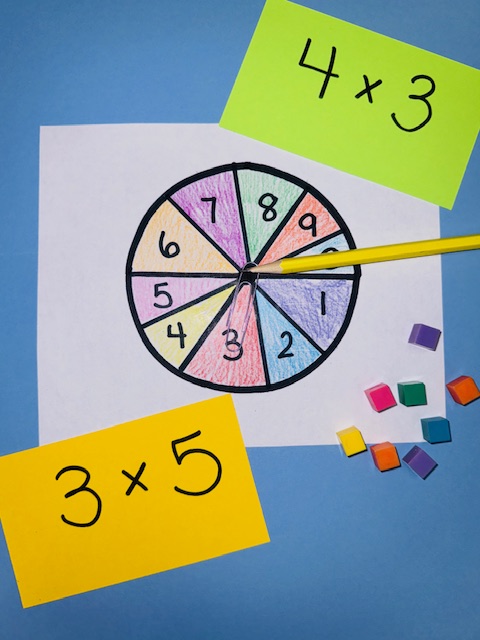
Make a simple spinner with a paper clip and a pencil. Start by having students draw a circle. Tracing around a coffee-can lid is an easy way to do it. Divide the circle up into 10 sections using a ruler. Color the sections and write numbers 0 to 9 on them. Place the paper clip and pencil down in the middle of the circle. Flick the paper clip so it spins. Whatever number it points to is your first factor. Spin again to find the second factor. Multiply them, and that is your score for the round. Your partner does the same. The highest product wins that round. To make it more fun and motivating, put out a set of 20 marbles or cubes. As a player wins a round, they get a cube or marble. Whoever has the most after all are taken is the winner.
Animal Multiplication Stories
You can use animals as the stars of some multiplication stories due to their unique physical characteristics. For example, one story might be, “An octopus has eight legs. Six octopi came to an undersea birthday party. How many legs were there at the party? (8 x 6 = 48 legs).” Let students choose an animal or you can assign one. They should then write a short multiplication story about their animal, solve it, and illustrate it. The picture should match the problem. Consider using horses, cats, dogs, or spiders, and think creatively. For instance, you can count horses’ eyes, ears, legs, tails, and so on.
The Grapes of Math
Read aloud Greg Tang’s math picture book The Grapes of Math (Scholastic, 2004) for some very focused listening and problem-solving with multiplication. Provide each student with a whiteboard and marker. Have students listen to each page and rhyming problem and record on the whiteboard the multiplication fact that matches that page and solves the rhyme. You can do them all in one sitting or spread them out one or two per day. These are all great fun, clever, and sometimes quite challenging.
All Hands on Deck!
Here’s a fun and active way to model some multiplication. Have a group of three students stand in a line at the front of the room. Ask the group to throw out a certain number of fingers. For example, you might say, “Each person please throw out four fingers.” Then ask the rest of the class what multiplication fact they are modeling. In this case it would be 3 x 4 = 12. After that, have various numbers of students come up to form a group and model facts. The rest of the class has to guess the fact aloud or write them on a whiteboard with a marker.
You can also let groups you call huddle up and decide among themselves how many fingers they will throw out when they model their next fact.
Sticky Multiplication Arrays
Kids love stickers, and you can buy inexpensive sets of some really tiny stickers. Give a page of tiny stickers, a pencil, and a piece of graph paper to each student. Then have kids arrange the stickers in arrays on the graph paper, outline them with a pencil, and write matching multiplication facts for each. This is a good activity to assign with an entire fact family, like the sevens for instance. This way students can observe how the facts build incrementally both in number and area.
Multiplication Mistakes
Kids love to correct the teacher. Here’s an activity that gives everyone a chance to do just that. Create a paper where you write 100 multiplication facts with products. Make an error in at least half of them. Make a copy of the paper for each student. Pass these out and explain that this paper was recently handed in to you by your friend Mug the caveman. He is new to math and may have made some mistakes. Ask them to correct the paper by circling the mistakes and writing the correct number next to the error. Student focus on these is incredible!
Number Line Hop
Partner students together and provide them with a number line from 1 to 100, a couple of counting bears or similar game pieces, and a deck of multiplication fact cards. Then players take turns pulling cards from the deck. They solve the fact and move that number of spaces on the number line. First player to the end wins. Players have to pay careful attention as the game progresses because with each round, they have a different starting point. For example, if your first card is 3 x 4, since the product is 12, you hop from 0 to 12. If your second card is 2 x 3, you now start on the 12, move 6 spaces, and land on 18. You can also play this same game on a 100 chart if a number line takes up too much space.
Rubber Stamp Multiplication
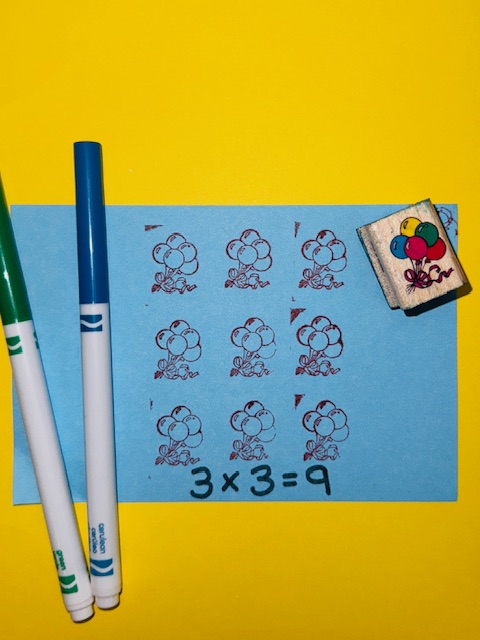
I’ve yet to meet the child who does not like to use a rubber stamp. You can buy almost any kind of rubber stamps, from moons and stars to cats and dogs to flowers and dragons. Get a dozen or so different stamps and some ink pads. Provide students with white drawing or construction paper, an ink pad (can be shared), and a rubber stamp.
Have students stamp out multiplication facts that you decide on for them. This is a good opportunity to work on facts that a student finds difficult. For example, if the target fact is 7 x 8, students would stamp seven rows of eight items in each row. Then they would write the fact and product underneath. Have students take turns trading stamps and ink pads so they can try different images and colors.
Money Multiplier
Make a special spinner that has pictures of the U.S. coins: penny, nickel, dime, quarter, half dollar, and dollar. (You can use a piece of card stock with a coffee-can lid traced on it to form a circle. Divide the circle with a pencil and ruler into six sections, one for each coin, but with the higher-value coins getting smaller sections. For a spinner, use a pencil and a paper clip.
Provide a group of four or five students with a set of play coins. Then put these in the middle of the group along with the spinner. Students take turns spinning and taking one of the coins that the spinner points to. As they play and collect coins, they place like coins in rows in front of them. So, a row of pennies, a row of nickels, a row of dimes, and so on. Give students 10 turns each. Then ask students to write a multiplication fact for each row of coins and the resulting product. They should then add up their products and see what their total coin value is. Highest value wins!
How Old Is the Class?
This intriguing activity combines surveys, data collection, and multiplication to answer an interesting question: “How old is the class?”
Introduce the problem by saying, “I’d like to find out how old this class is. I mean, all together.” Begin by collecting some data. If you are teaching 3rd grade, for example, you can ask students to: “Raise your hand if you are 7.” Then write down that number of students on the board. After that, ask, “Raise your hand if you are 8.” Write down that number of students. And finally ask students to “Raise your hand if you are 9.” Write down that number of students. Say, “Here is the data we need. Now could you all multiply these numbers and then add all the years together? That will tell us how old the class is.”
5 kids x 7 years old = __ years
10 kids x 8 years old = __ years
6 kids x 9 years old = __ years
In this case, 5 x 7 = 35, 10 x 8 = 80, and 6 x 9 = 54. Add them together: 35 + 80 + 54 = 169 years.
You can extend this by sending teams of students out to various classrooms to collect data, do the multiplication and addition, and then find out who has the oldest class in the grade level or in the school.
Kaboom Sticks
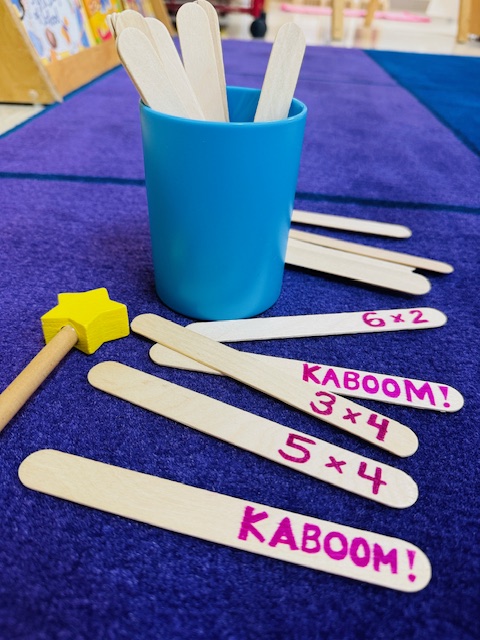
Get a set of wooden craft sticks and write multiplication facts on them, except for a few sticks on which you write “Kaboom!” Then put the sticks with the facts side down in a can. This is a fun activity for a small group. Students take turns pulling sticks from the can. If they get the fact correct, they keep the stick and grow their collection. If they get it wrong, they put it back in the can. And if they pull a “Kaboom” stick, they put their whole collection back in the can.
Triangle Fact Cards
Sometimes just a little change-up can keep things fresh. Students are used to rectangular fact cards, but triangles are a different story. Cut out or have students cut out triangles from oaktag or other durable paper. Then give a set of 10 to each student and assign them a set of facts like ones, twos, threes, and so on. At the top of the triangle, they write the sum, and in the lower corners the two factors. In the middle write a multiplication sign. Color can be added and then cards laminated for long-term use. These sets are somehow more fun to use in games and activities that practice facts.
100-Chart Multiplication Patterns
Make multiple copies of a 100 chart for each student. Also provide crayons or colored pencils, a pencil, and lined paper. Ask students to color in a certain number pattern. For example, you might ask them to color all the numbers that end in 5 or 0 or 8. Then after they have found these, they should write down all the multiplication facts that will result in these numbers as products. Ask them to look for patterns. Have a discussion at the end of each round, and compare what each student has found. There are some intriguing patterns to be discovered!
Room Arrangement Multiplication Hunt
Before students come into the classroom, take certain items and arrange them in groups around the room. For example, set up five stacks of books with four books in each stack, three piles of rulers with eight rulers in each pile, nine index cards with five paper clips on each, three chairs in a circle, and so on.
When students enter, give them each a lined paper on a clipboard and a pencil. Have them sit down and explain that certain items have been gathered in different parts of the room. Their job is to find the items, don’t touch them, but write a description of what they found along with a multiplication fact that matches each arrangement. It’s great fun every time you do this.
Mysterious Multiplication Number Muncher
Ask students to come to the board and write a compete multiplication fact with product. Take turns until you have at least 12 facts on the board. Then ask students to hide their eyes while you erase one number from each problem. Make a monster noise and open and close the door and say, “Open your eyes. The Multiplication Number Muncher was just here and he munched some of the numbers. Who can help us replace them?” Allow students to come up and replace the missing numbers until all are correct. The anticipation is great every time you do this one!
Looking for more activities on how to teach multiplication? Try these Teacher-Tested Tips and Activities for Teaching the Area Model Multiplication Method .
Plus, get all the latest teaching tips and ideas when you sign up for our free newsletters .
Copyright © 2024. All rights reserved. 5335 Gate Parkway, Jacksonville, FL 32256

Learn the Multiplication Facts Faster
We're here to help students learn the multiplication facts. It's kind of our thing.
Activities and Resources
Our activities and resources are proven to help kids learn the multiplication facts
Step by step instruction
Lessons that make a difference
Our unique approach to teaching the multiplication facts has made the difference for millions of learners across the world
Activities that adapt to each student
Meet the student right where they are
Backed by data, our quizzes, games, and other tools automatically meet the student exactly where they are to prevent frustration.
Have fun and enjoy learning
Exciting games that kids love
Our games help students get excited about learning the multiplication facts. Study's show that games are a very effective way to learn.
Our customers love our learning system
Testimonials
Don't just take our word for it, read from educators who've found success using multiplication.com.
Every student benefits from this unique approach to learning multiplication facts. The real strength of this program is the salvation it offers the academically challenged and at-risk learner. Karol - Third Grade Teacher
My son struggled in math last year gradually losing self-confidence. I knew it was because he just didn't know those facts. He has almost completed the program and tests with 100% accuracy. Diane - Parent
What I enjoy most about Multiplication.com is that it allows me to monitor student progress in real time. Students enjoy it because, with Zippy as a guide and games to entertain them, the program feels more like playing than working. Scott - Third Grade Teacher
After trying other online services, we finally found that multiplication.com was the answer. The lessons just made sense to our daughter. John - Home School Parent
What we offer
© 2024 IXL Learning. All rights reserved.
Our goal is to help students learn the multiplication facts.
Notice Warning Success Something went wrong
10 times table worksheets
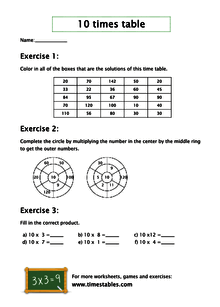
Free 10 times table worksheets
The 10 times table is often one of the first tables a student will learn. Naturally, we have excellent free worksheets available for the 10 times table. For many teachers, these worksheets are part of their lesson plan. Of course, you can also print them out and take them home with you and prepare yourself for future maths lessons.
The answers to the 10 times table are relatively easy. You only have to add a 0 and you'll have the answer. For example, 4 x 10 = 40. Here you have a 4, to which you simply add a 0 to get the answer: 40. The same applies to, for example, 7 x 10 = 70. Here you have a 7, to which you add a 0 to get the answer.
The times tables are the basis of more elaborate calculations and one's general maths comprehension. The exercises provided here are suited for maths education taught in primary school. These free 10 multiplication table worksheets for printing or downloading (in PDF format) are specially aimed at primary school students. You can also make a multiplication worksheet yourself using the worksheet generator. These worksheets are randomly generated and therefore provide endless amounts of exercise material for at home or in class.

Register an account for free
And view your medals and diplomas in the trophy cabinet!

Username: (?) (Pay attention to privacy and don't use sirnames.) Only letters and numbers Password: Please re-enter your password:
Username: Only letters and numbers Password:

COMMENTS
For instance there are tables worksheets for 3th grade that you can print here. Multiplication facts worksheets. ... You can also use the worksheet generator to create your own multiplication facts worksheets which you can then print or forward. The tables worksheets are ideal for in the 3th grade. Menu. Menu
A complete set of free printable multiplication times tables for 1 to 12. These multiplication times table worksheets are appropriate for Kindergarten, 1st Grade, 2nd Grade, 3rd Grade, 4th Grade, and 5th Grade. Multiplication Times Tables Sized Chart This multiplication times table charts is a great resource for teaching kids their ...
The compact multiplication tables are basically lookup charts. To look up a multiplication fact, find the first factor in the column header and the second factor in the row headers; then use straight edges, your fingers or your eyes to find where the column and row intersect to get the product. These tables are better than the previous tables ...
The steps are: Step 1a: View, read aloud and repeat. To get familiar with the table. Step 1b: Fill in your times tables answers in sequence and check if you got them all right. Step 2: Drag the correct answers to the questions. Step 3: Fill in your answers for the mixed questions and check if you got them all right.
Worksheets » Multiplication Mixed Tables Worksheets. Worksheet Number Range Online; Primer : 1 to 4 : Primer Plus : 2 to 6 : Up To Ten : 2 to 10 : Getting Tougher : 2 to 12 : Intermediate : 3 to 15 : Advanced : 6 to 20 : Hard : 8 to 30 : Super Hard : 12 to 100 . Individual Table Worksheets. Worksheet Online; 2 Times : 3 Times : 4 Times : 5 ...
On this page you have a large selection of 2-digit by 1-digit multiplication worksheets to choose from. (example: 32x5) Multiplication: 3 Digits Times 1 Digit. On these PDF files, students can find the products of 3-digit numbers and 1-digit numbers. (example: 371x3) Multiplication: 4 Digits Times 1 Digit.
Multiplication Worksheets. These multiplication worksheets include timed math fact drills, fill-in multiplication tables, multiple-digit multiplication, multiplication with decimals and much more! And Dad has a strategy for learning those multiplication facts that you don't want to miss. When you're done, be sure to check out the unique spiral and bullseye multiplication worksheets to get a ...
These Multiplication Printable Worksheets below are designed to help your child improve their ability to multiply a range of numbers by multiples of 10 and 100 mentally. The following sheets develop children's ability to use and apply their tables knowledge to answer related questions.
There are a few remaining multiplication able facts that don't fit the rules, and these need to be memorized. Fortunately most of these are easy. 3x3=9, 3x6=18, 3x7=21,3x8=24, 6x6=36, 6x7=42, 6x8=48, 7x7=49, 7x8=56, 8x8=64. You'll notice that most of the multiplication table facts that need to be memorized come from the times 3 multiplication ...
Here's a set of four miniature reference tables that can be cut apart. 3rd through 5th Grades. View PDF. Multiplication Facts Chart - Blank (0-12) Print out this empty multiplication fact sheet that ranges from 0 through 12. 3rd through 5th Grades. View PDF. Multiplication Fact Chart - Filled In (0-12)
Get 600+ multiplication worksheets. Free! Master basic times tables, decimal multiplication, & more with drill sheets, word problems, & other fun printables.
Download and printout our FREE worksheets HOLIDAY WORKSHEETS - Free Secret Word Puzzle Worksheets New YearsWorksheets Martin Luther King Jr.Worksheets
These multiplication table worksheets for grade 2 in pdf are randomly generated and therefore provide endless amounts of exercise material for at home or in class. The best 4 times table worksheets for printing can be found here. These practice sheets include various assignments for primary school students.
Grade 5 multiplication worksheets. Multiply by 10, 100 or 1,000 with missing factors. Multiplying in parts (distributive property) Multiply 1 digit by 3 digit numbers mentally. Multiply in columns up to 2x4 digits and 3x3 digits. Mixed 4 operations word problems.
Practice and master times tables with printable math worksheets for 3rd grade and up. Fun and easy to use for home or school.
These printable multiplication worksheets have a row of multiplication problems all with factors up to 10. Students can write their answers in the space provided. 3rd and 4th Grades. View PDF. Multiplication Squares Puzzle (Basic Facts 0-9) Fill in the empty squares with factors that will complete the puzzle.
We've got 20 free multiplication worksheets for third and fourth grade, covering a variety of skills for students to practice. We'll cover the following: Multiplication worksheets -- grade 3. Multiplication Facts (0-9) Multiplication Tables (0-12) Multiply multiples of 10; Multiplication properties; Multiplication word problems
And if we did that we get 3 plus 3 is 6. 6 plus 3 is 9. 9 plus 3 is 12. And we learned up here, this part of the video, we learned that this same multiplication could also be interpreted as 3 times 4. You can switch the order and this is one of the useful and interesting actually, kind of properties of multiplication.
The 5 times table is usually the 4th times table students will learn. This following the tables of 1, 2 and 10. The 5 times table can be easily remembered by adding 5 every time. The answers will always end in a 5 or 0. Moreover, when using the number line, you will make gradual jumps of 5. This will look as follows: 5, 10, 15, 20, 25, 30, 35 etc.
This activity exactly mirrors the 'Multiplication Tables Check' that will be given to children at the end of Year 4. They are tested on their multiplication tables up to 12 x 12. There are twenty-five questions and children have six seconds to answer each question and three seconds between questions. The questions are generated randomly using ...
Multiplication is really repeated addition but done in a very efficient way. Write a repeated addition sentence on the board, like 5 + 5 + 5 + 5. ... Provide some examples on the board such as these few from a 3 times table: 3 x 4 = open the door, 3 x 5 = bees in the hive, 3 x 6 = too many sticks, and so on. When completed, have students share ...
After trying other online services, we finally found that multiplication.com was the answer. The lessons just made sense to our daughter. Multiplication.com is the leading resource for helping kids learn the times tables and multiplication facts. Play free multiplication games, take auto-scored quizzes, drill flashcards, and access worksheets.
The times tables are the basis of more elaborate calculations and one's general maths comprehension. The exercises provided here are suited for maths education taught in primary school. These free 10 multiplication table worksheets for printing or downloading (in PDF format) are specially aimed at primary school students.